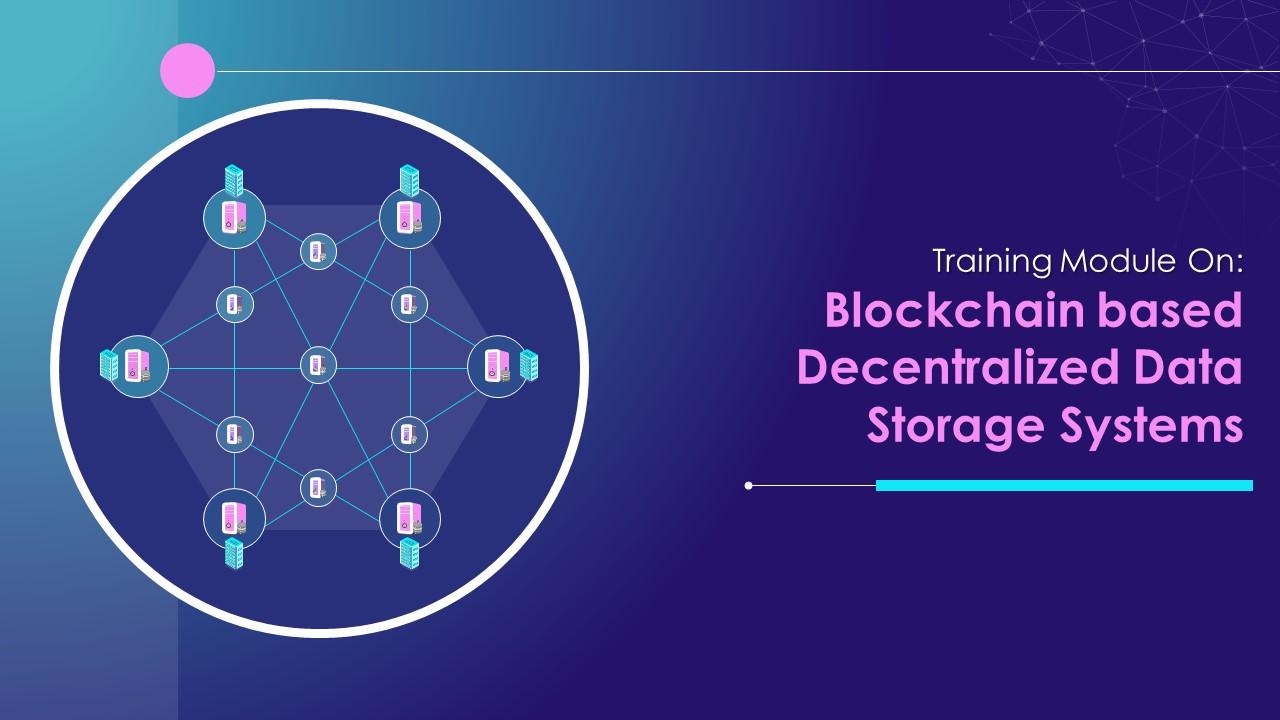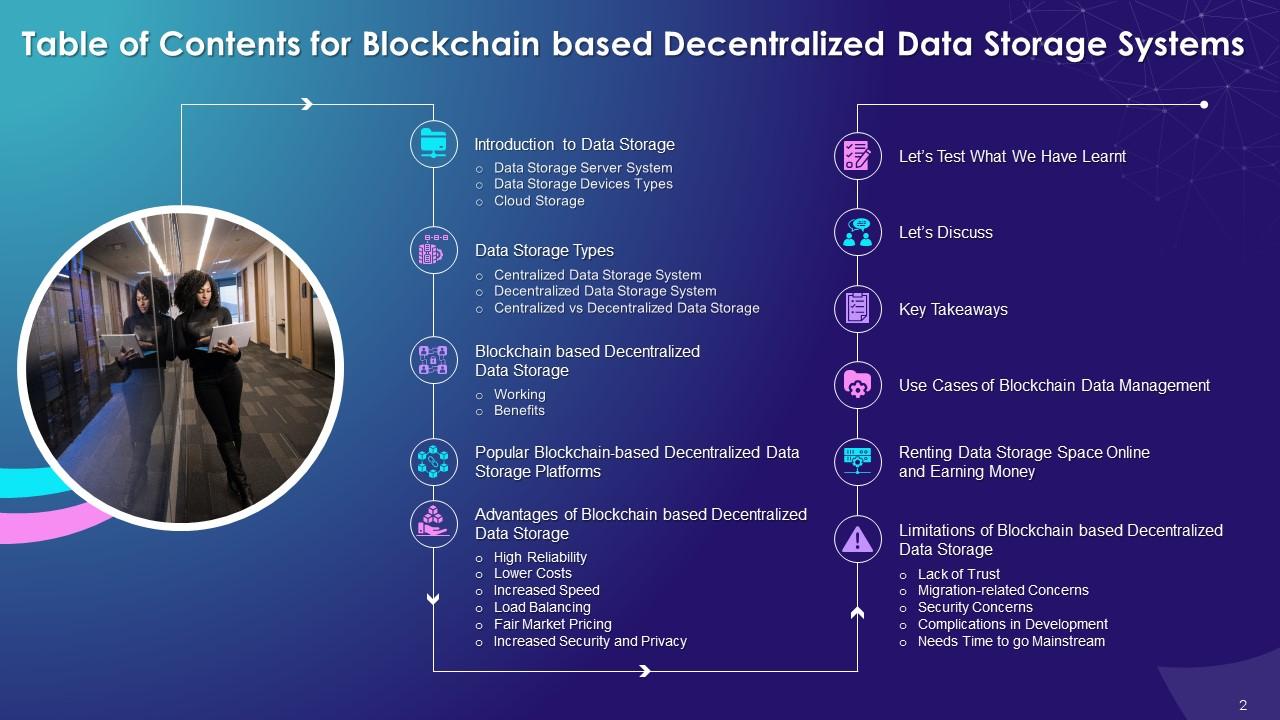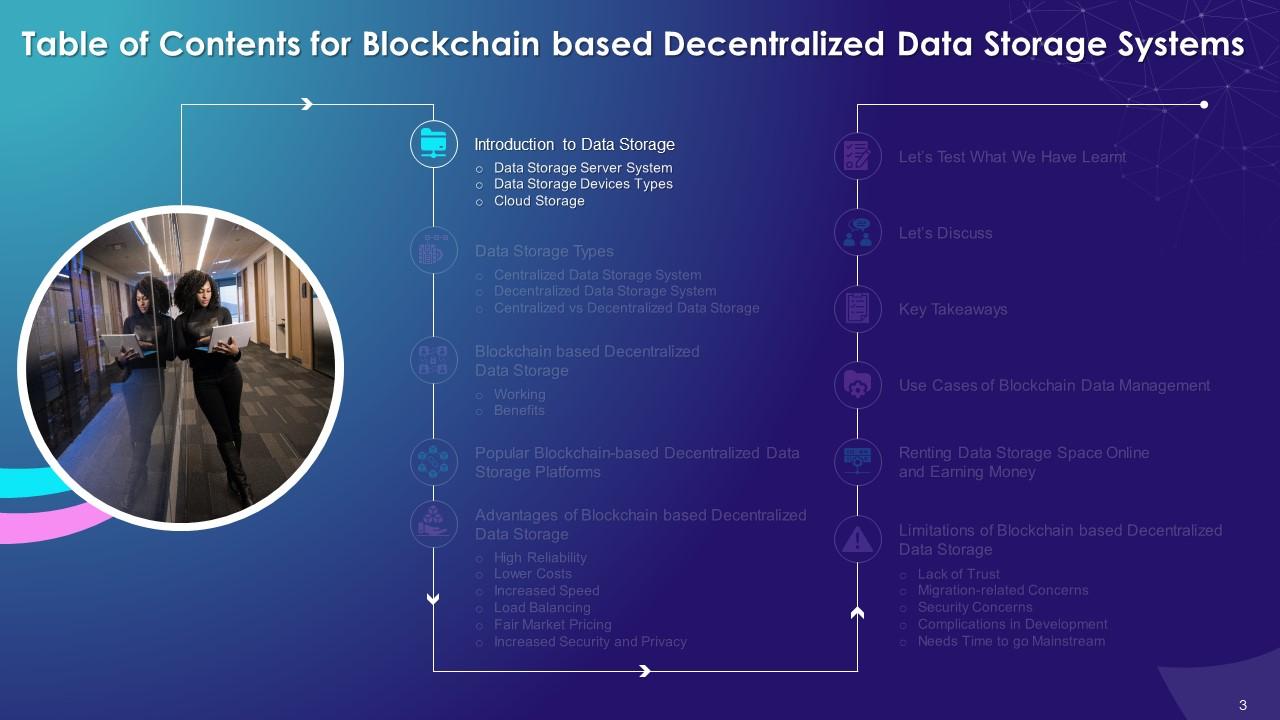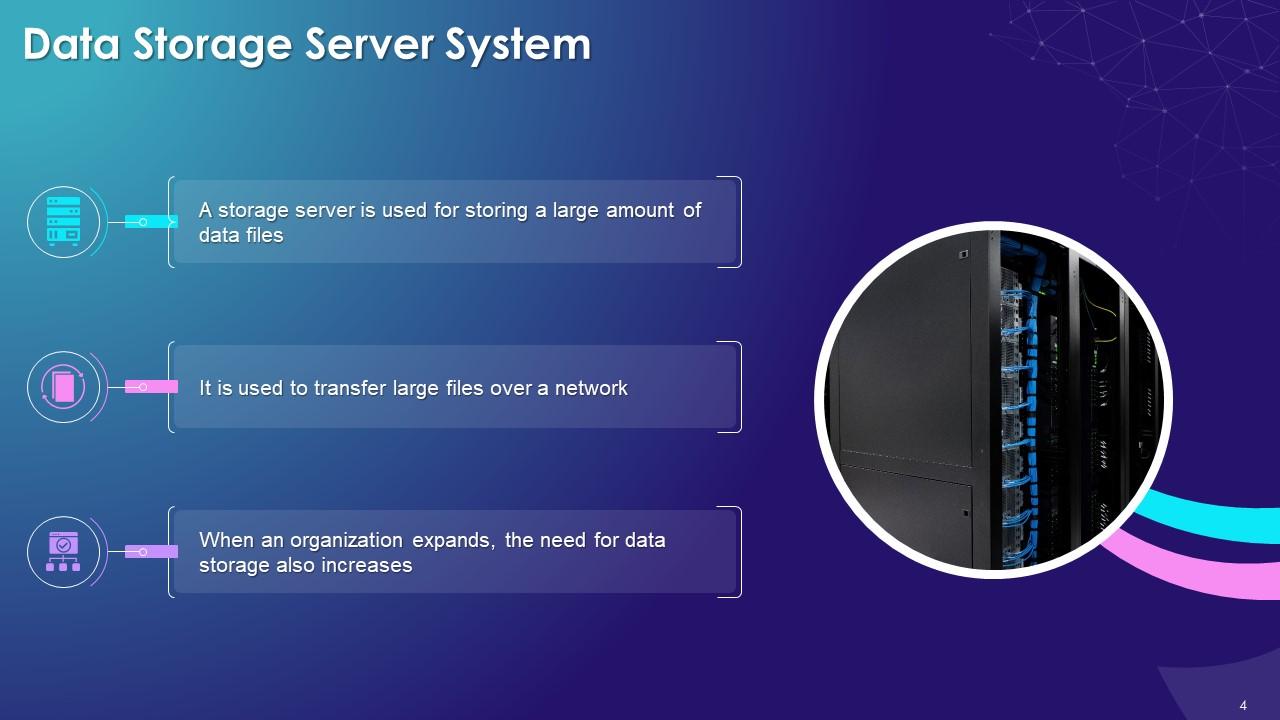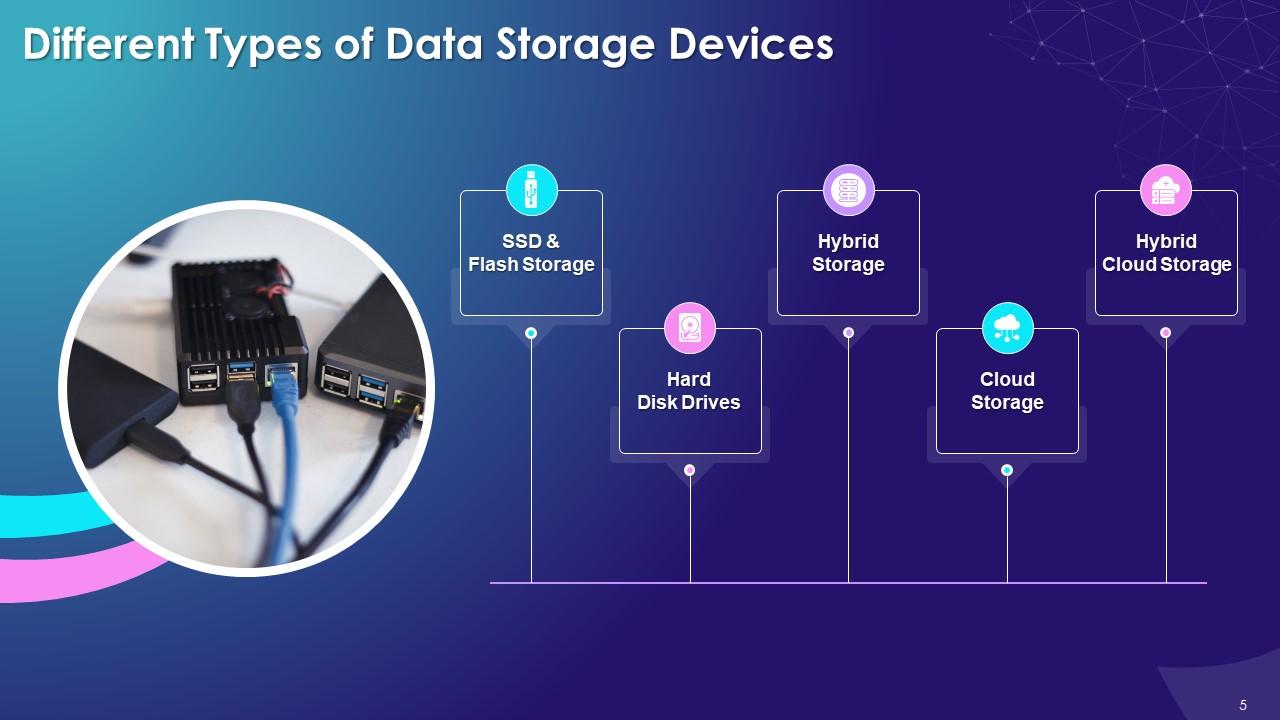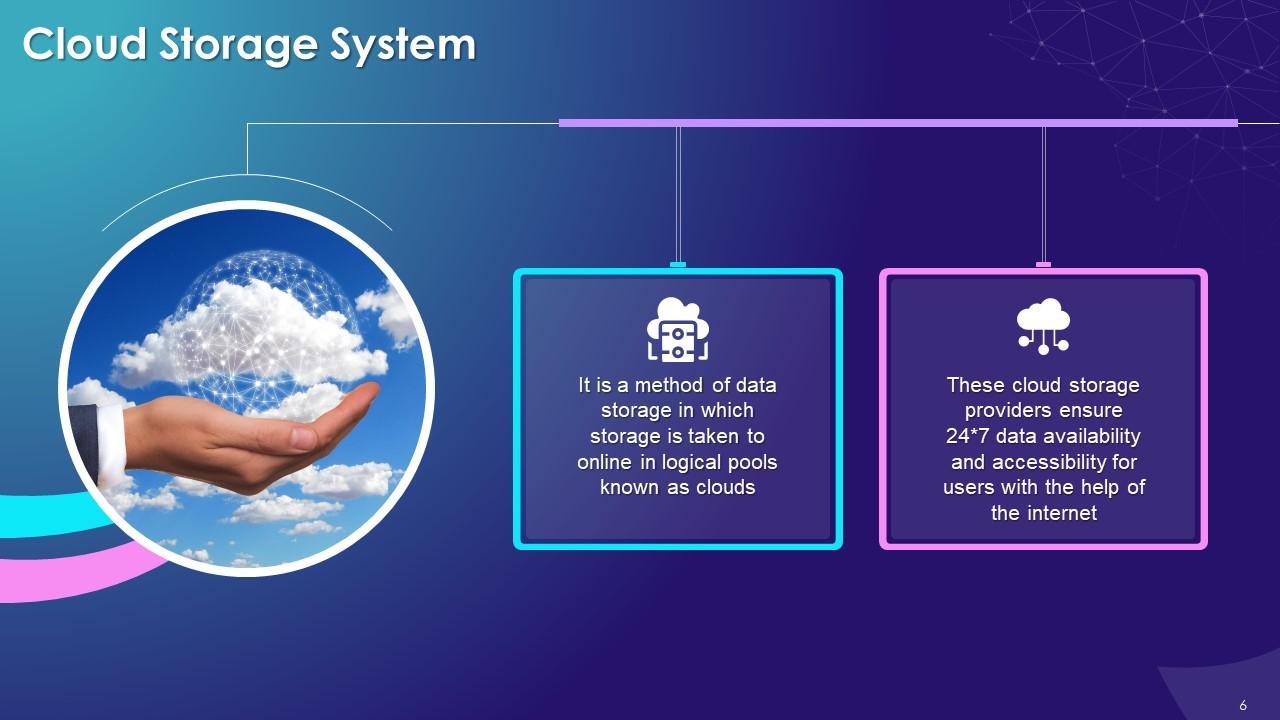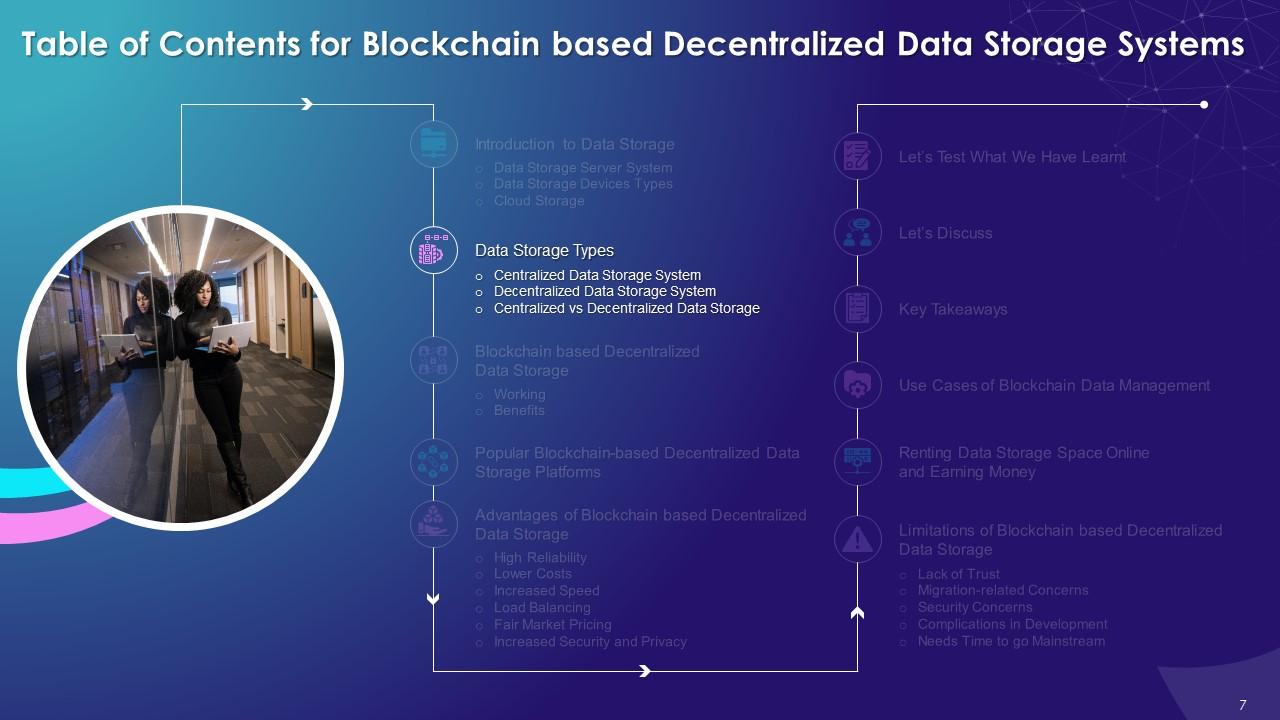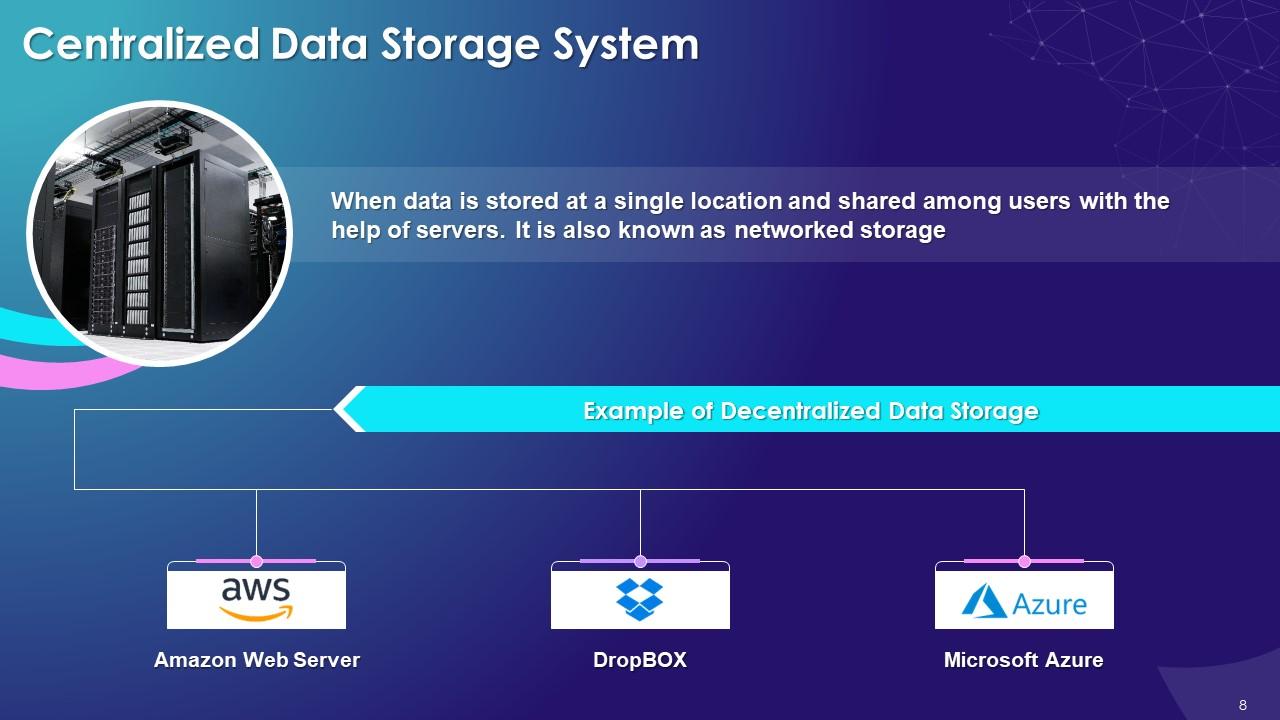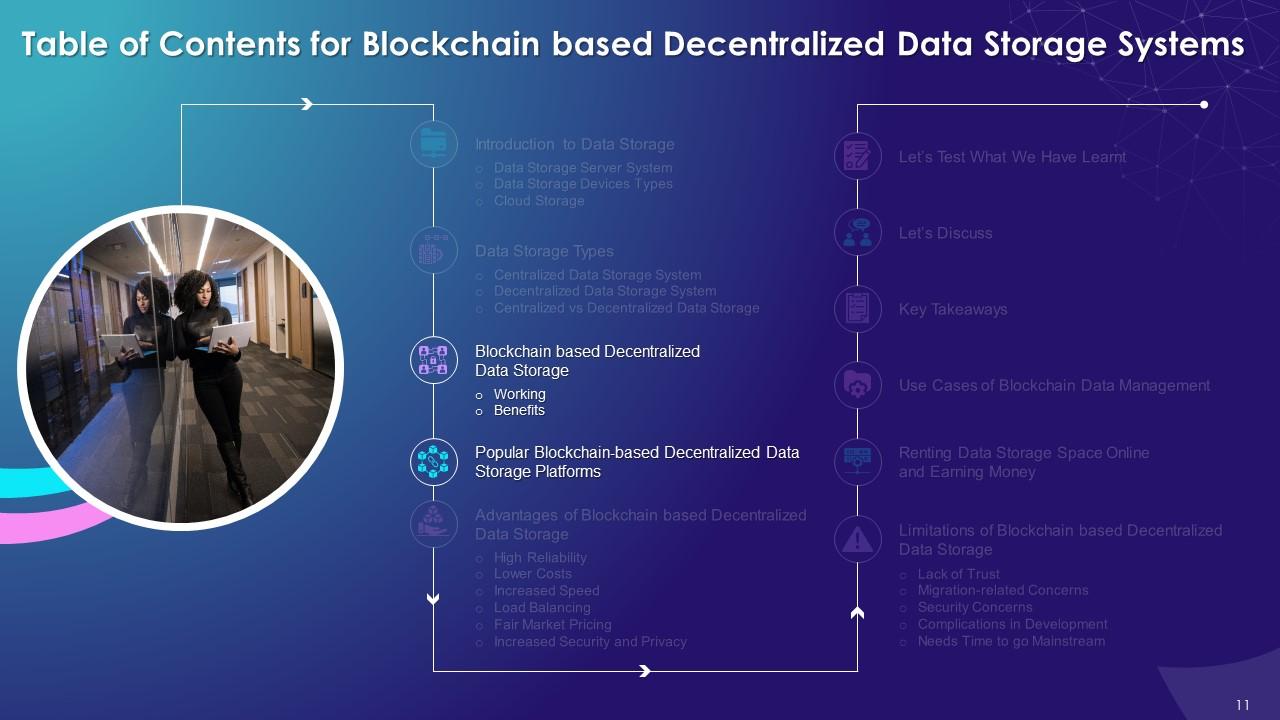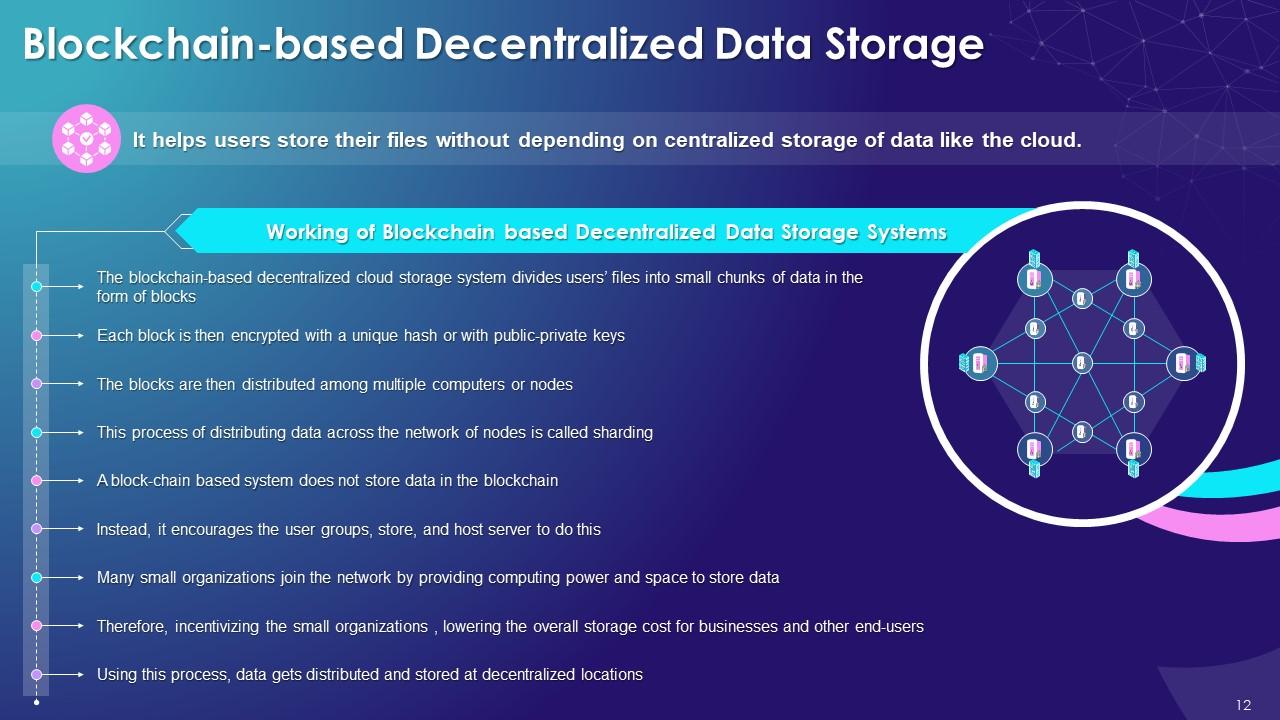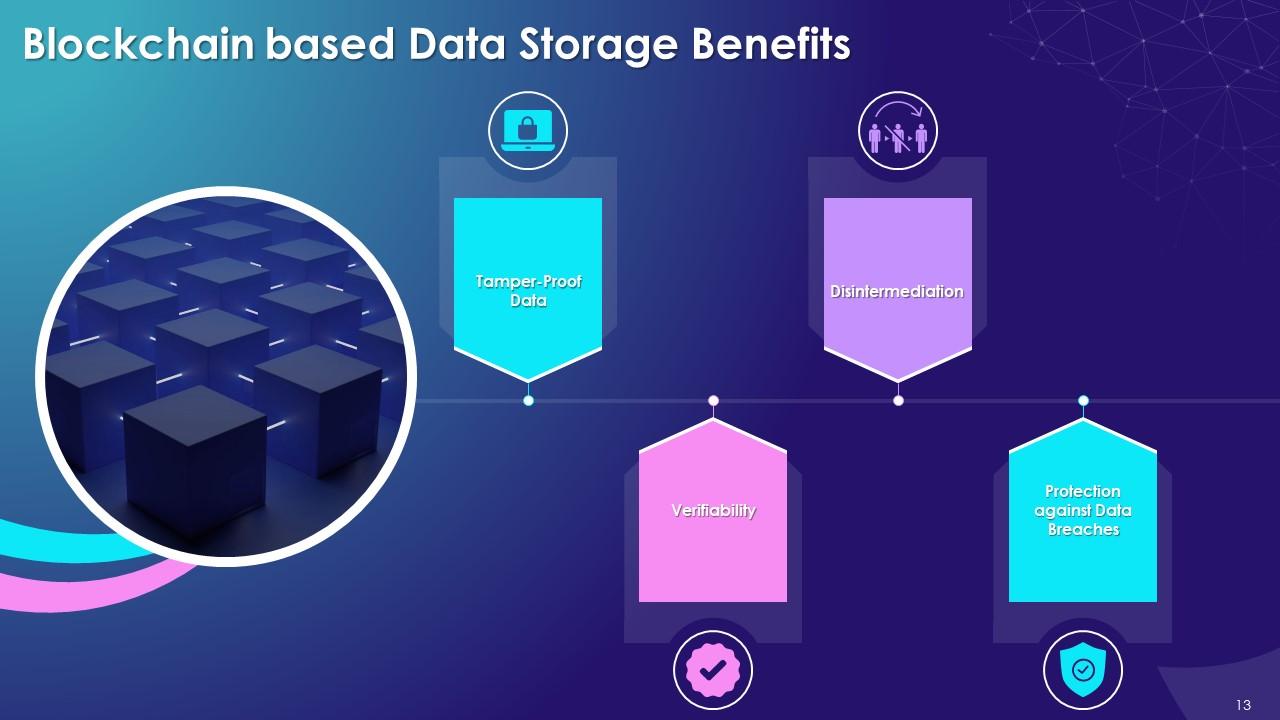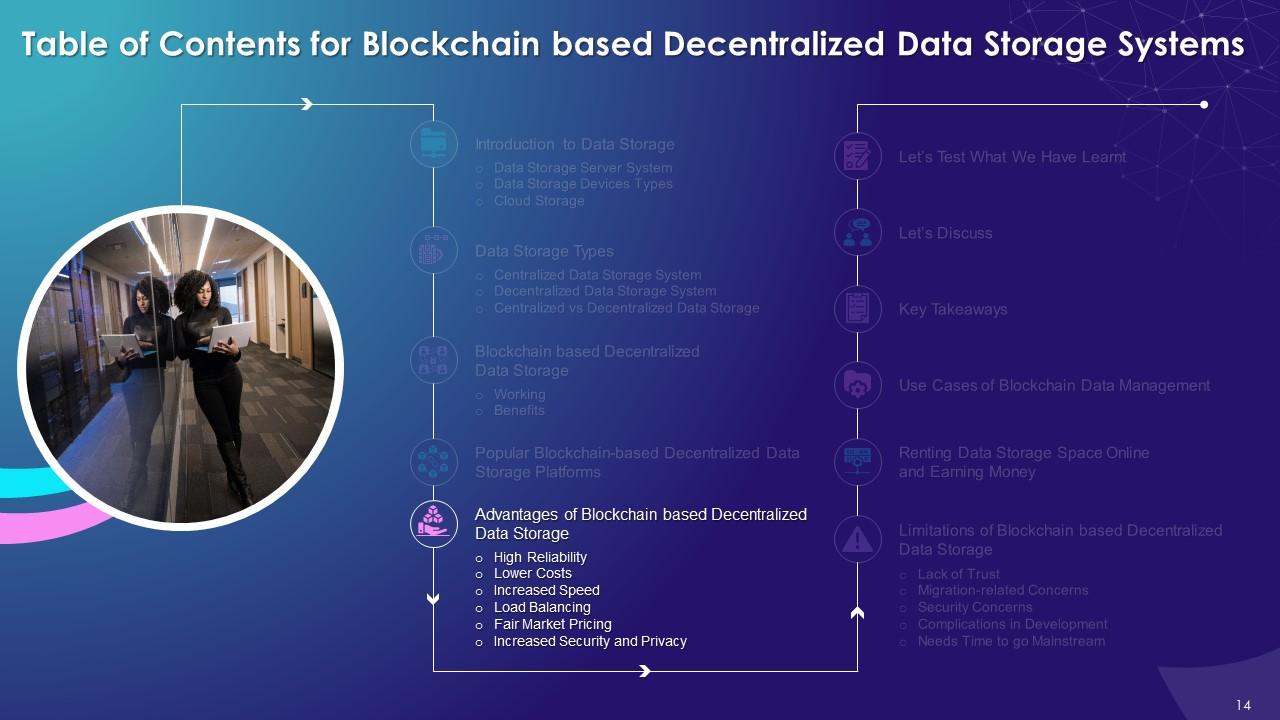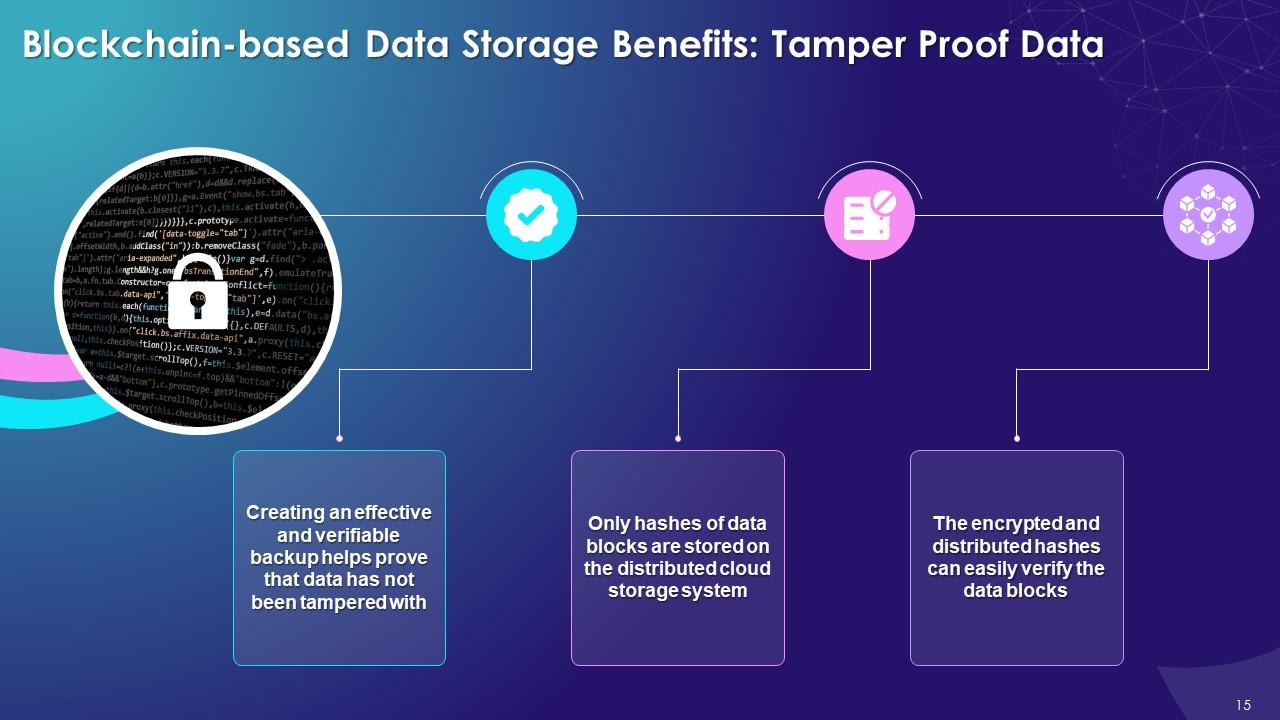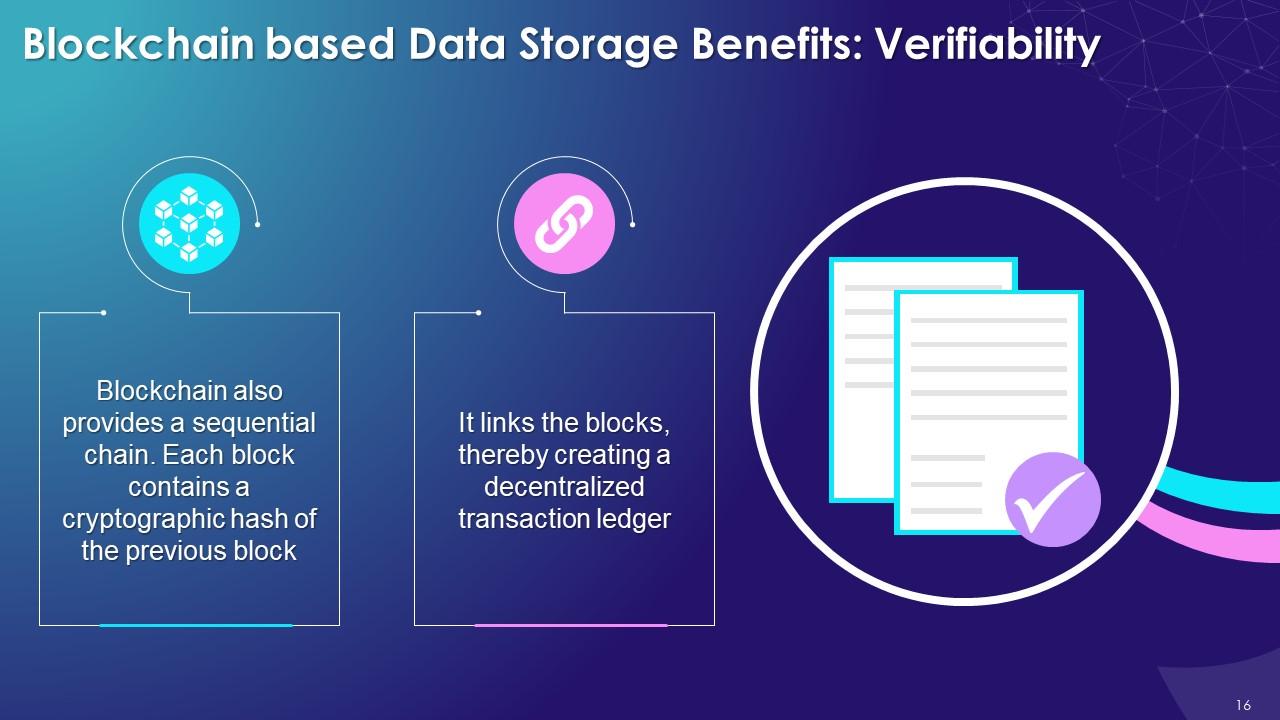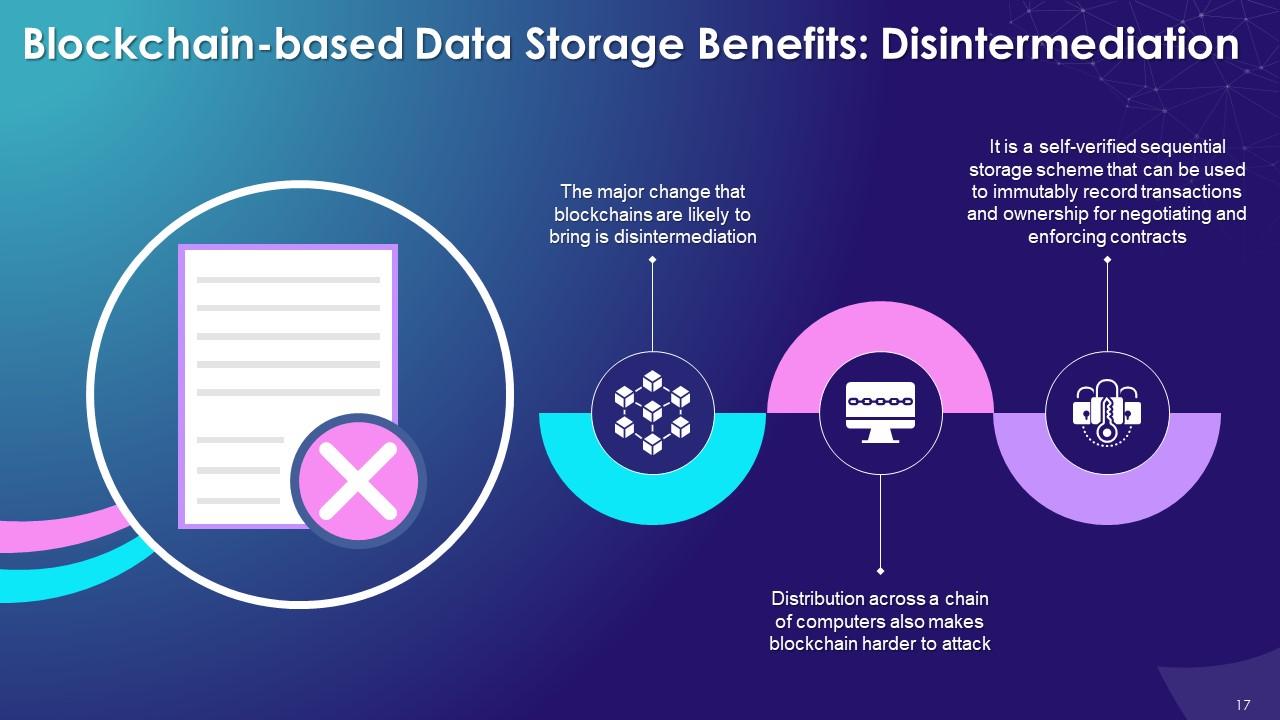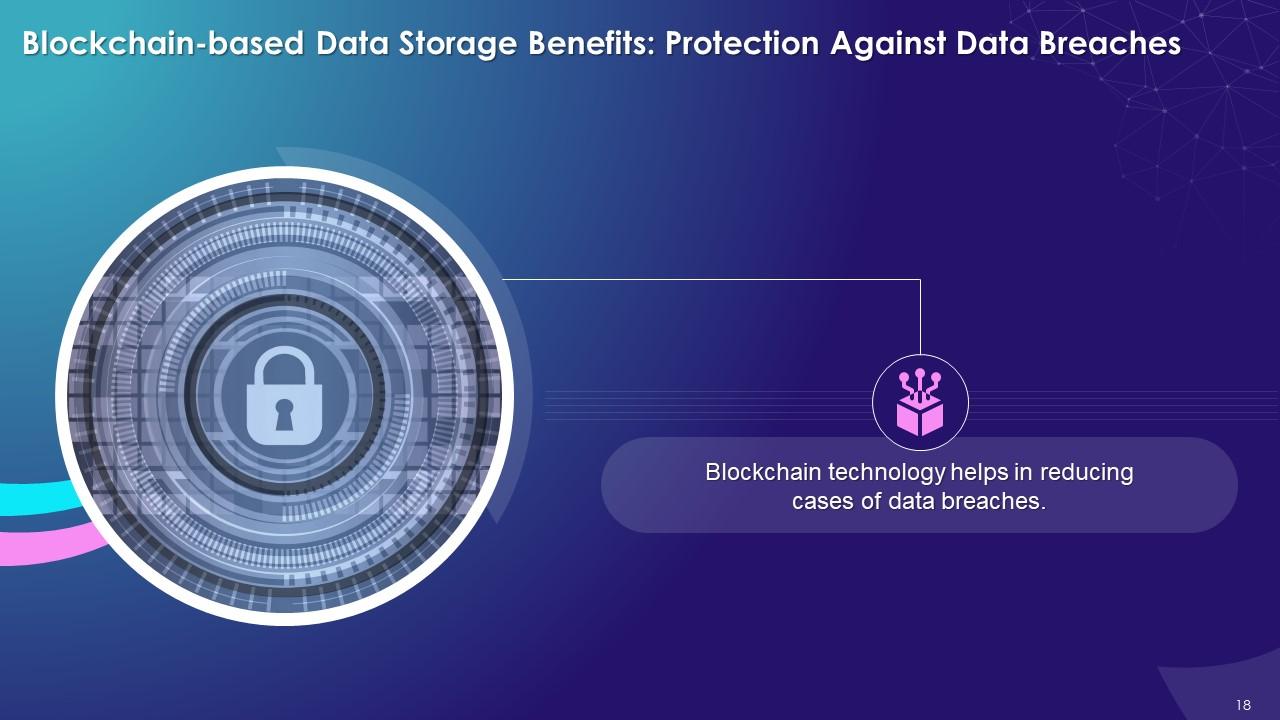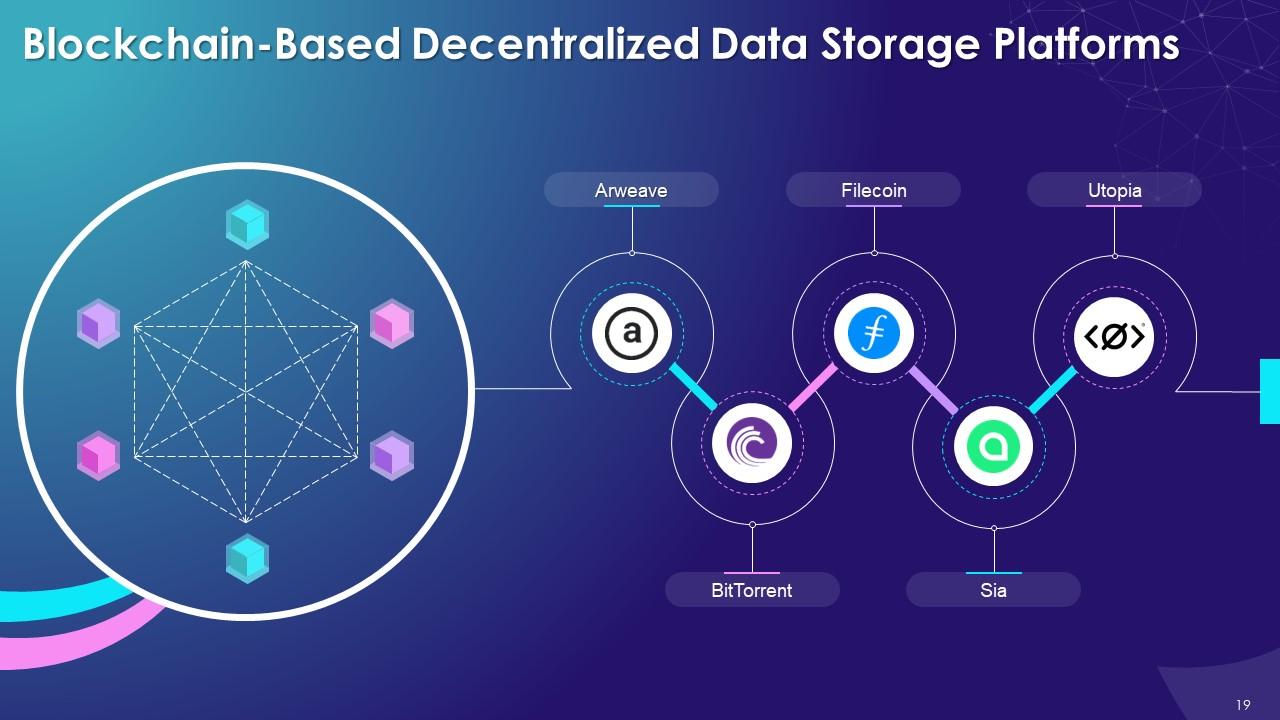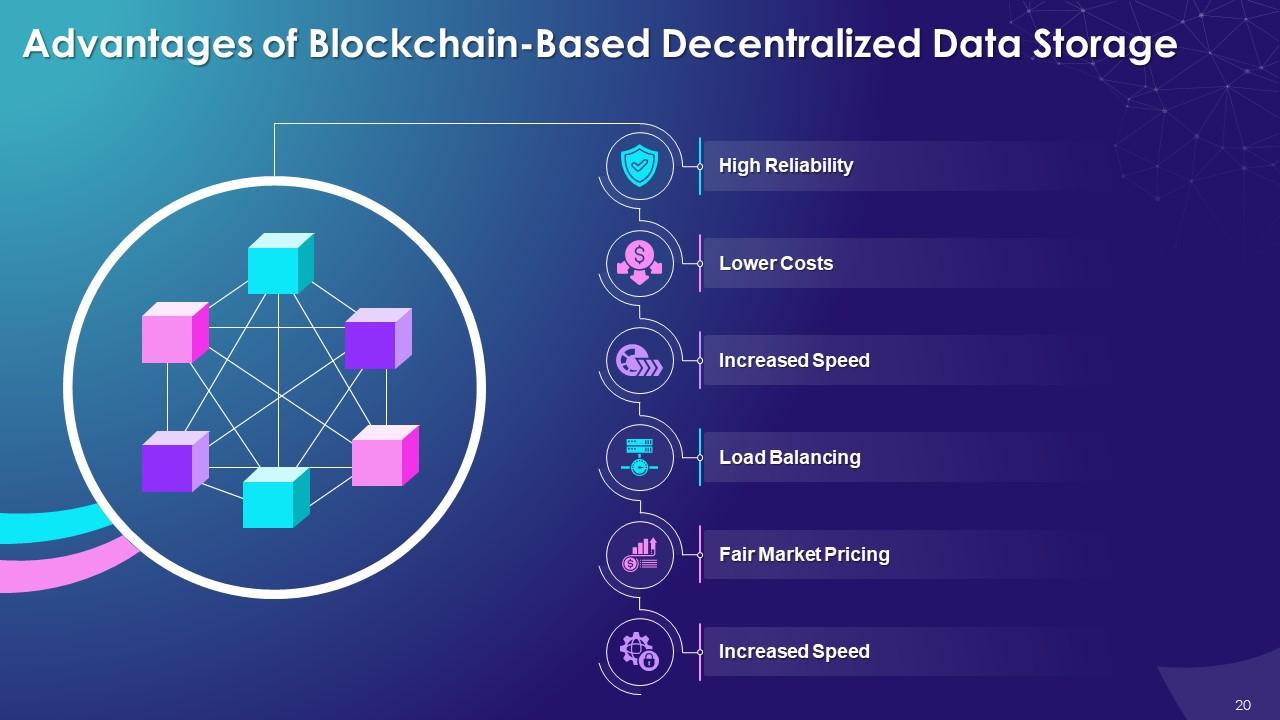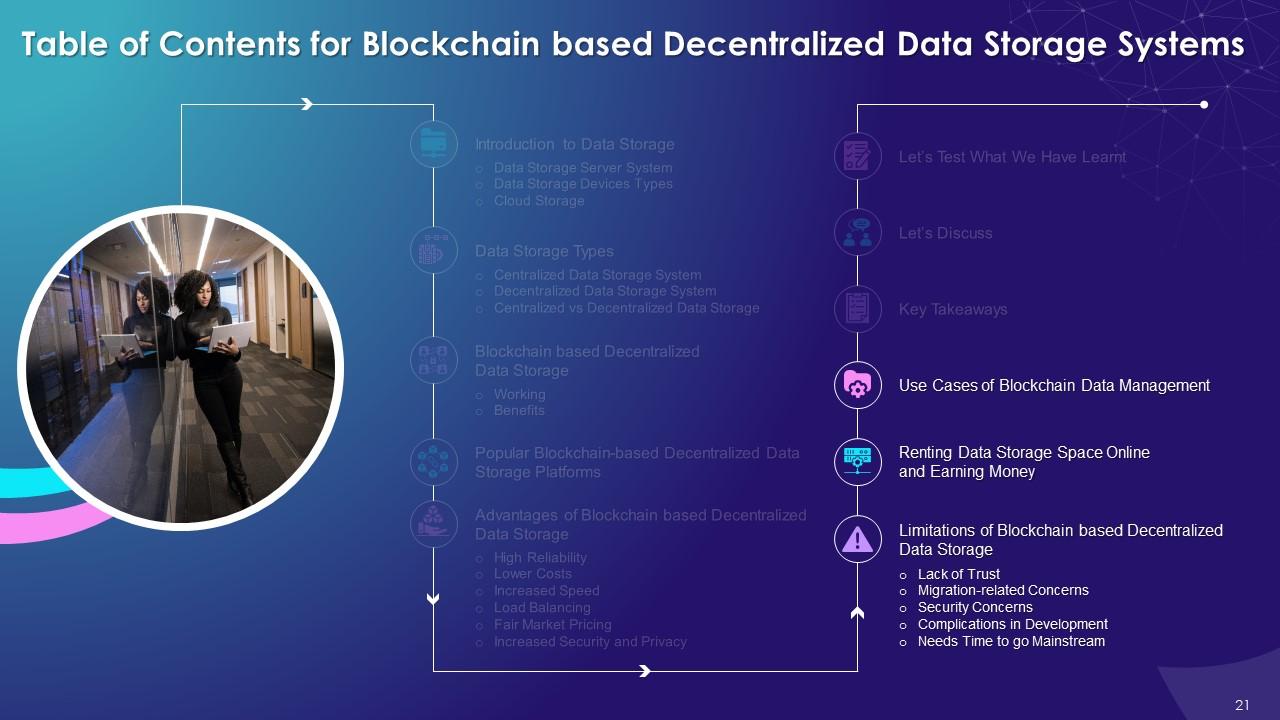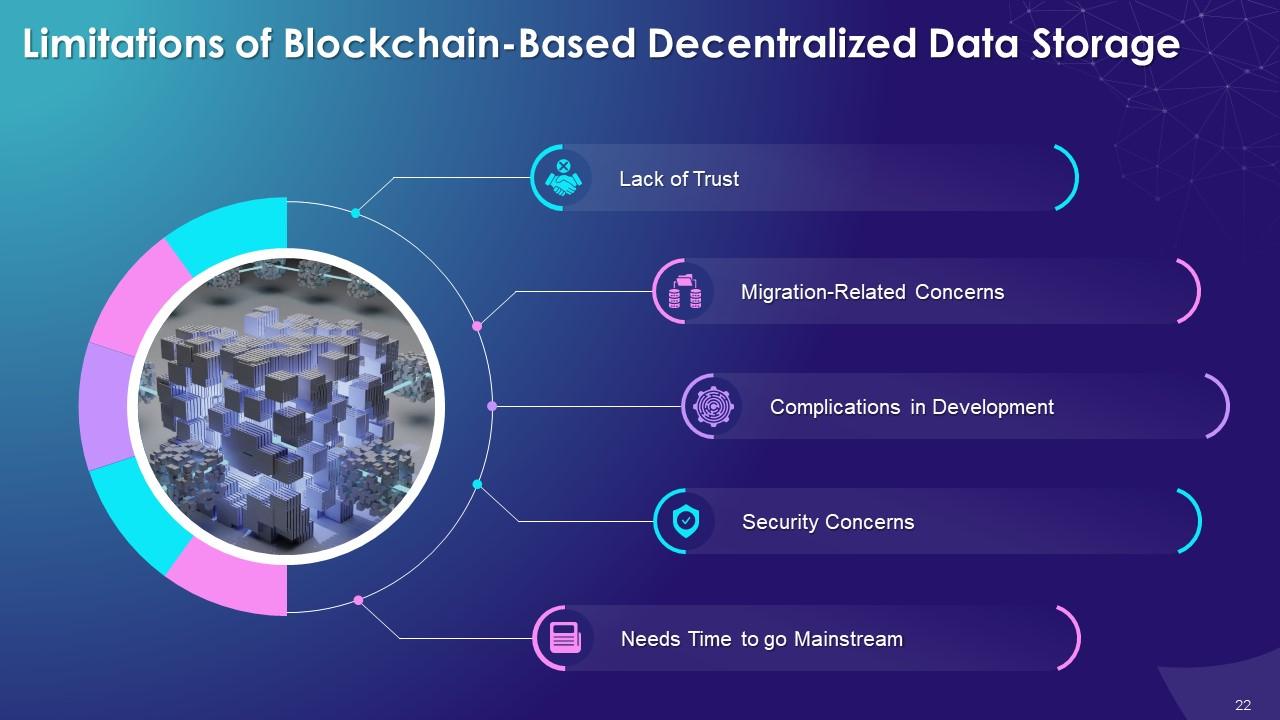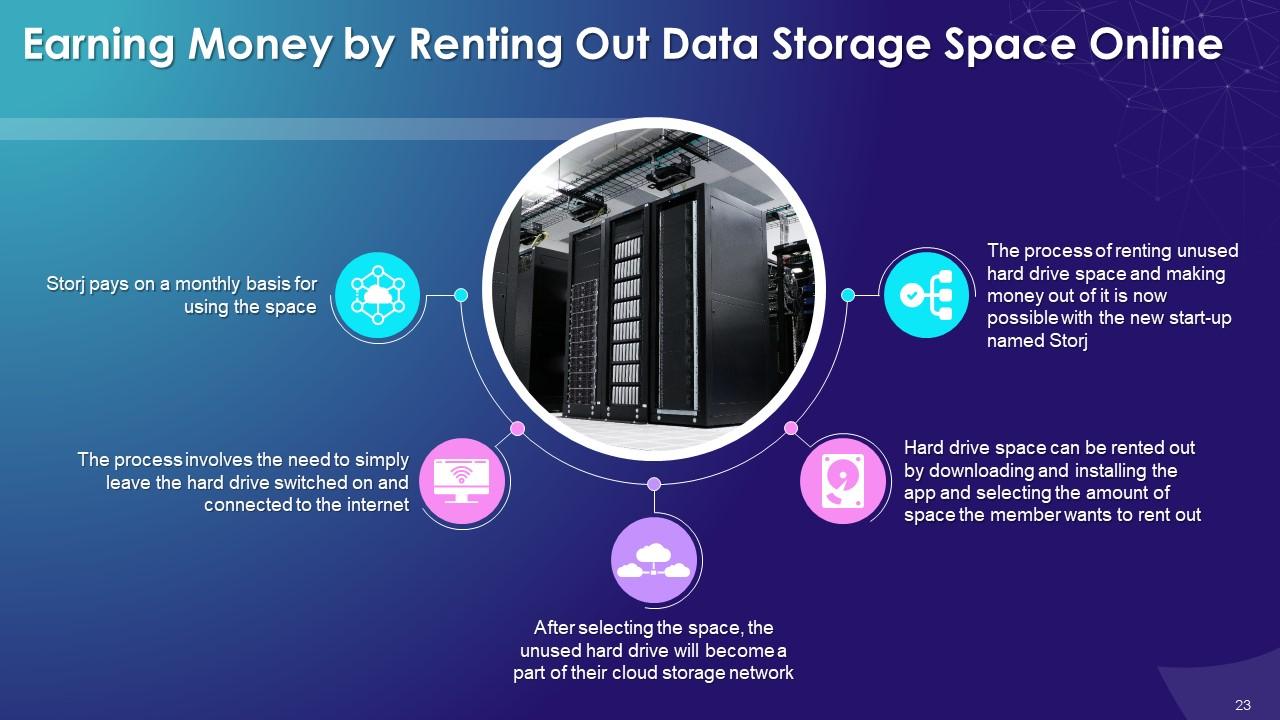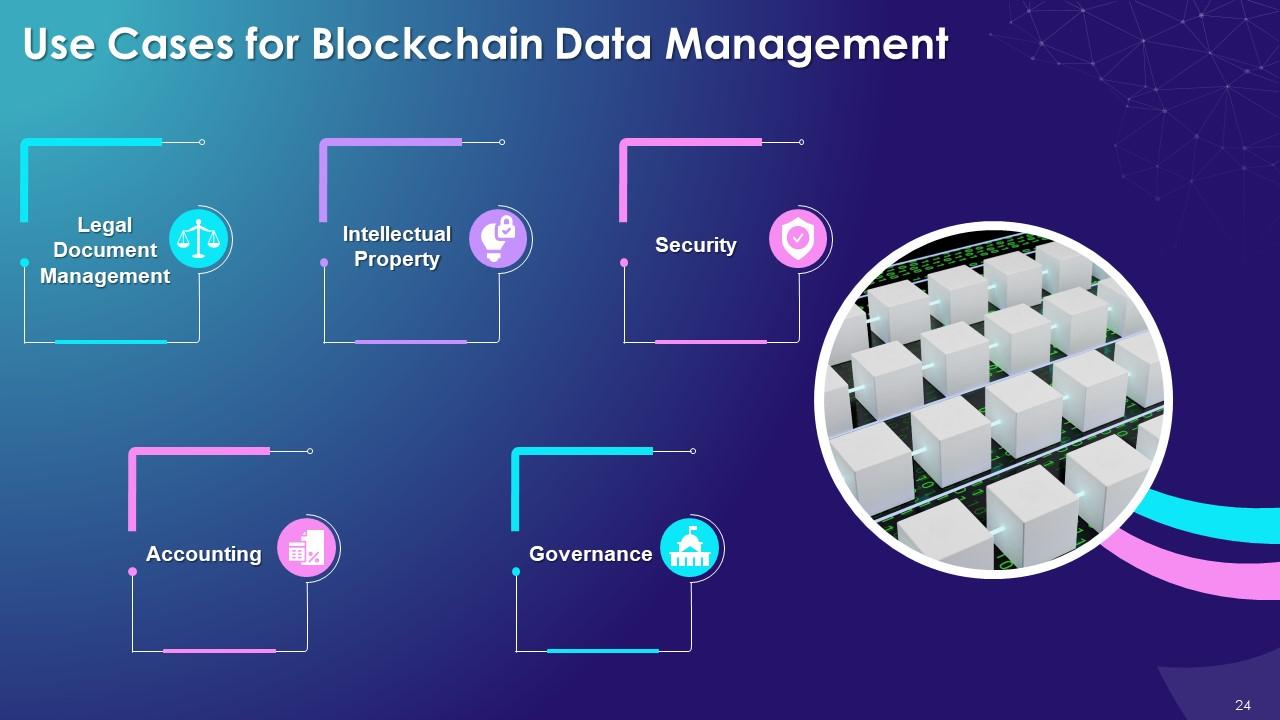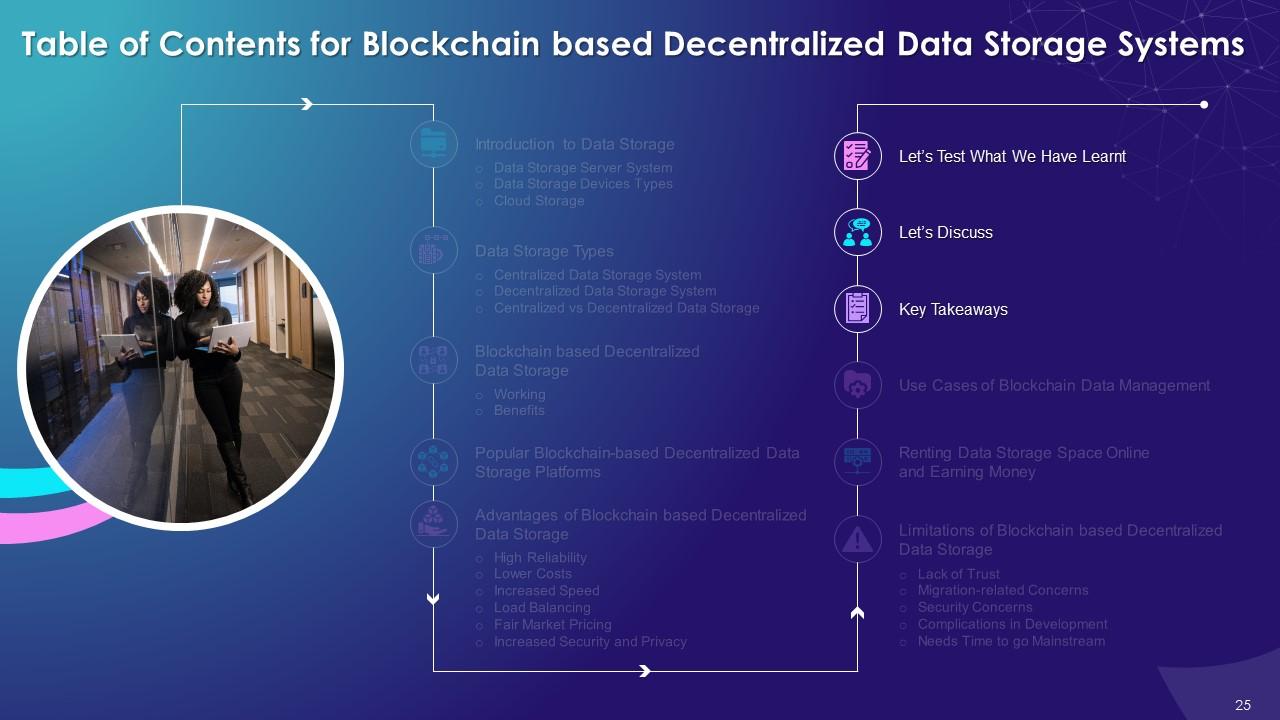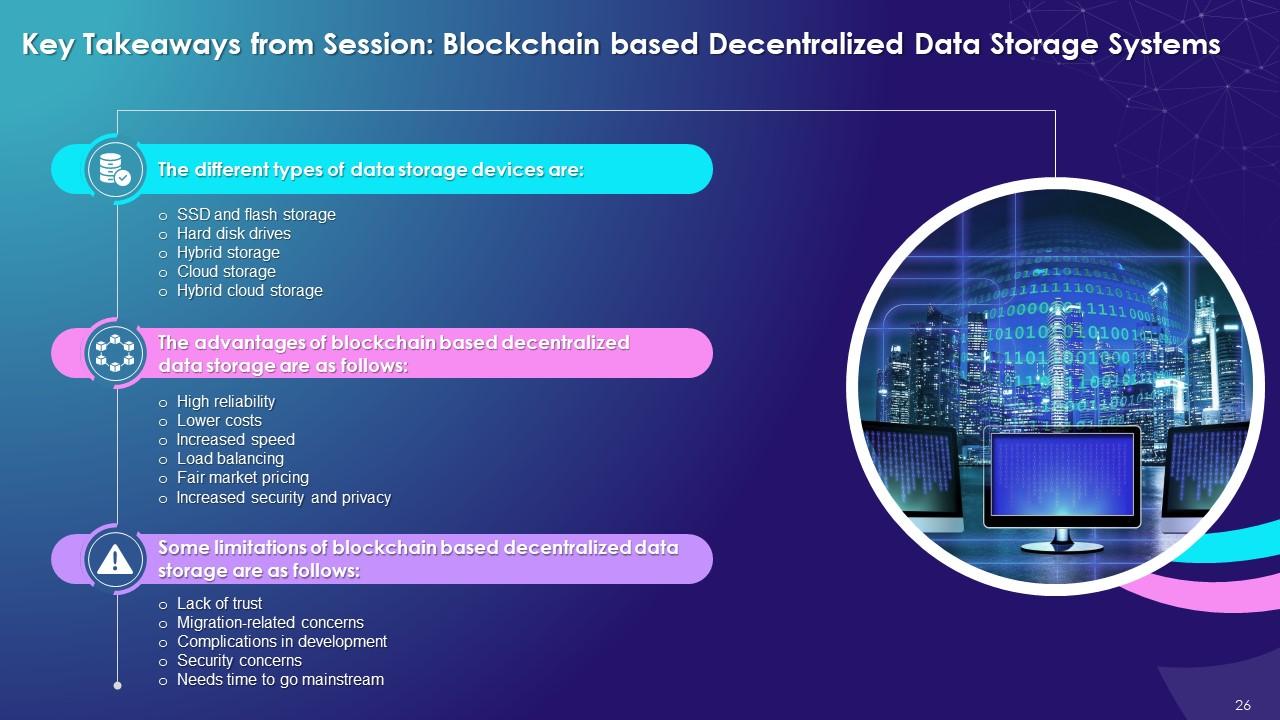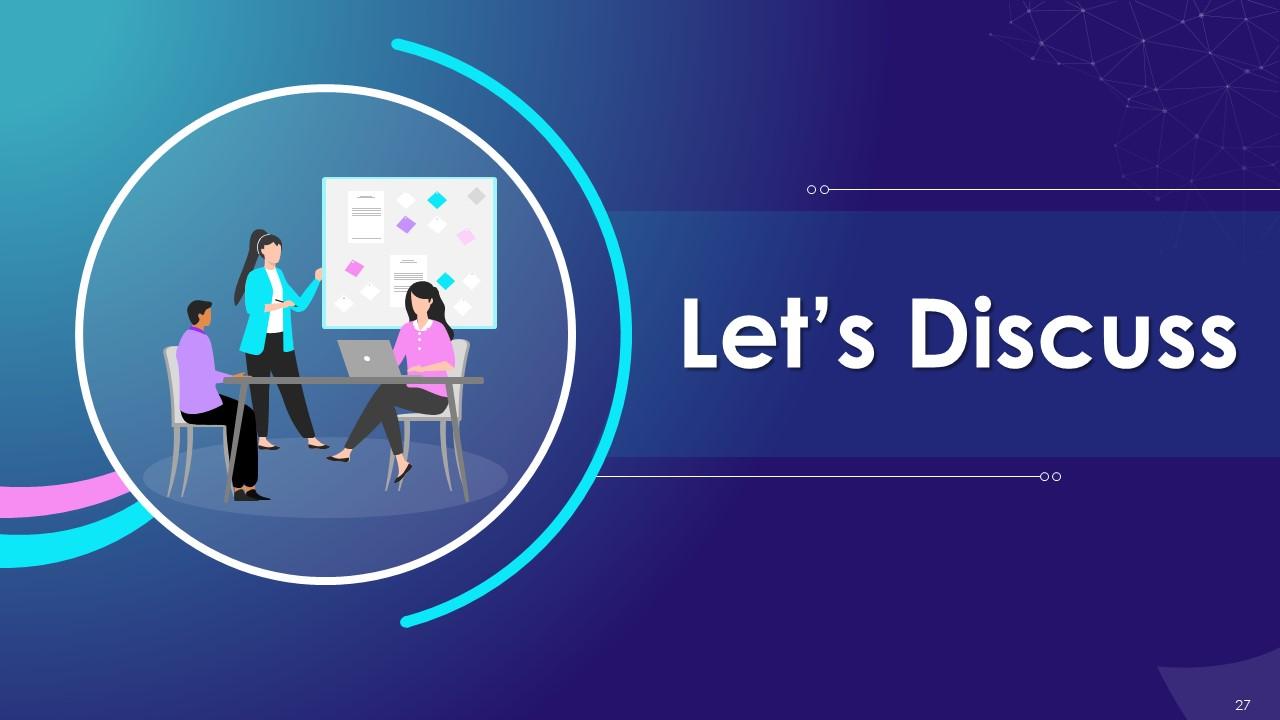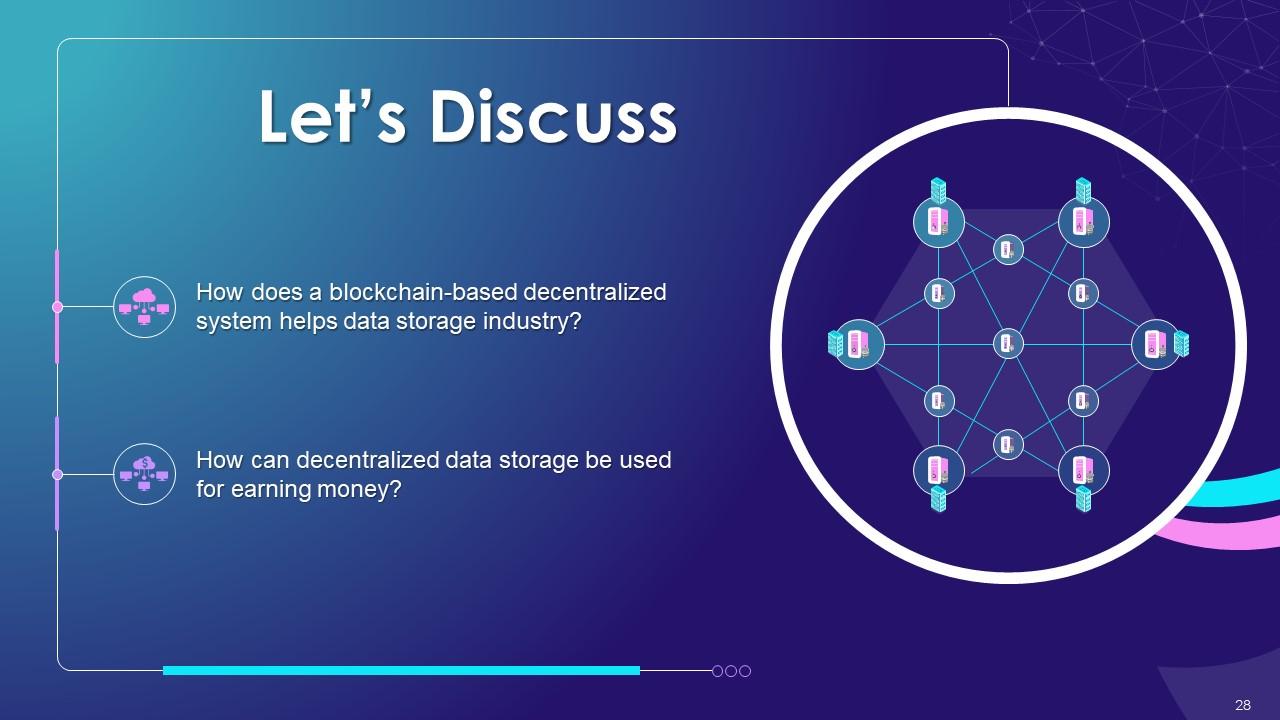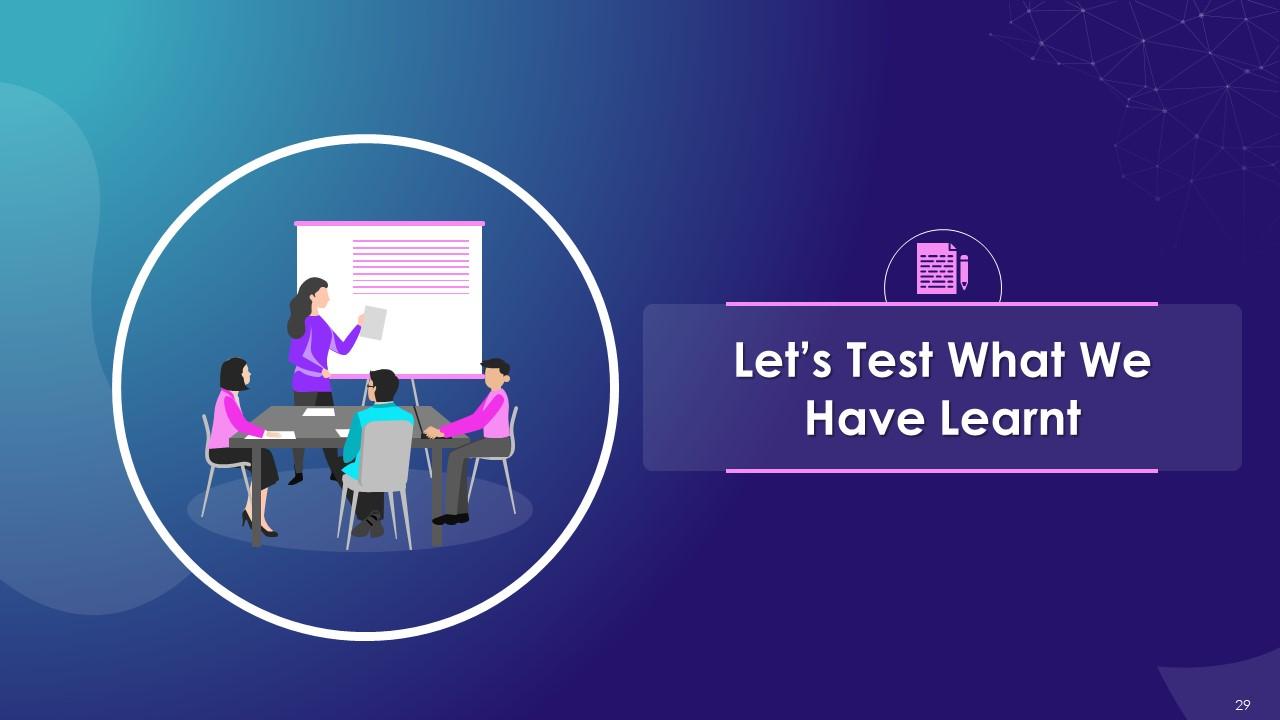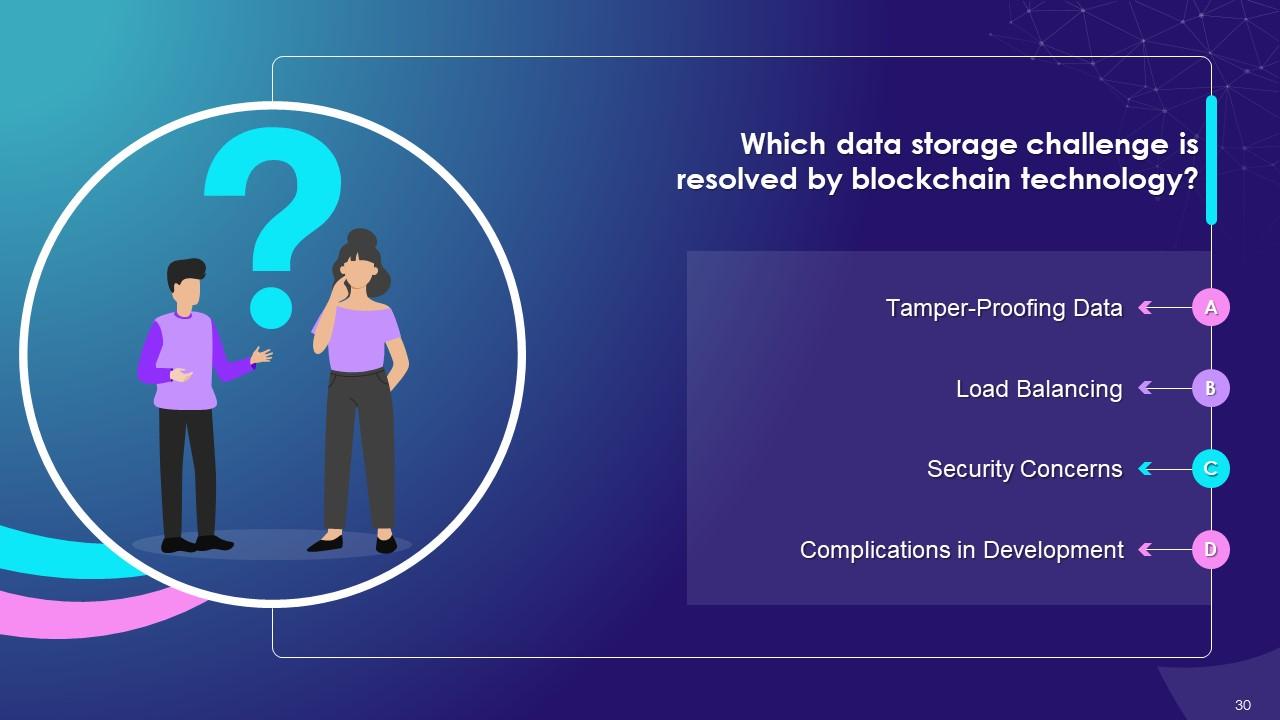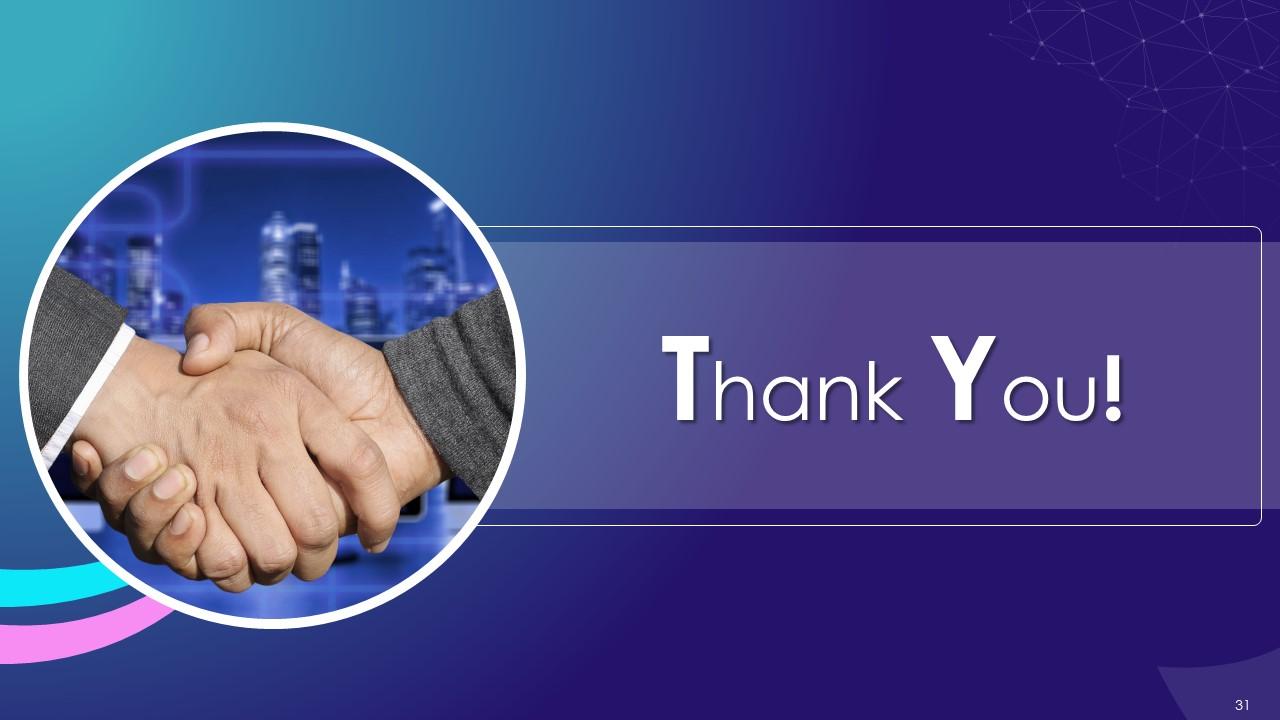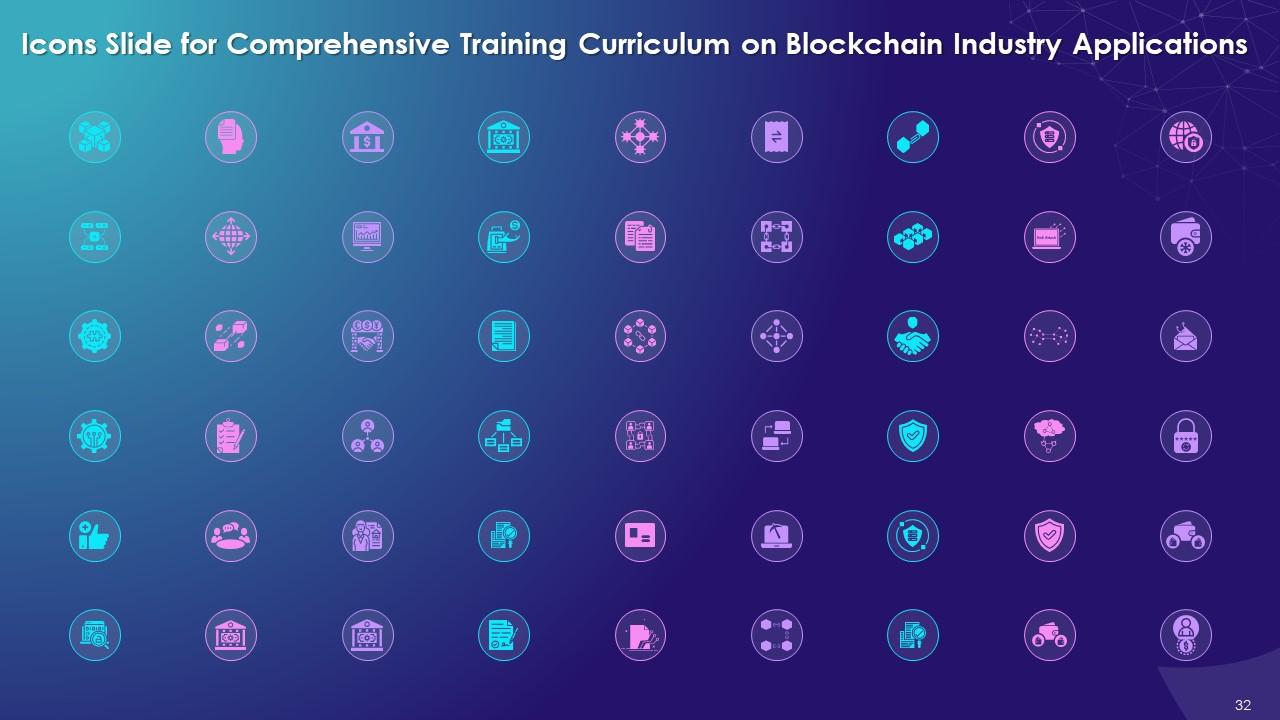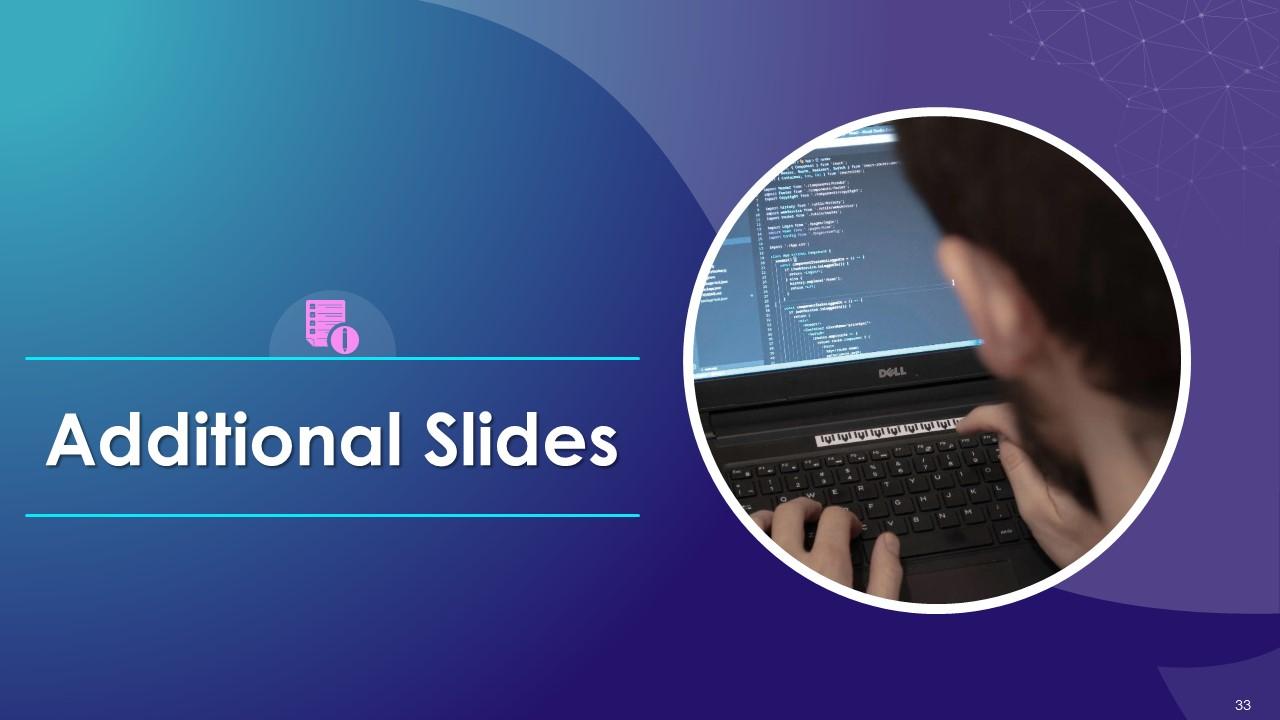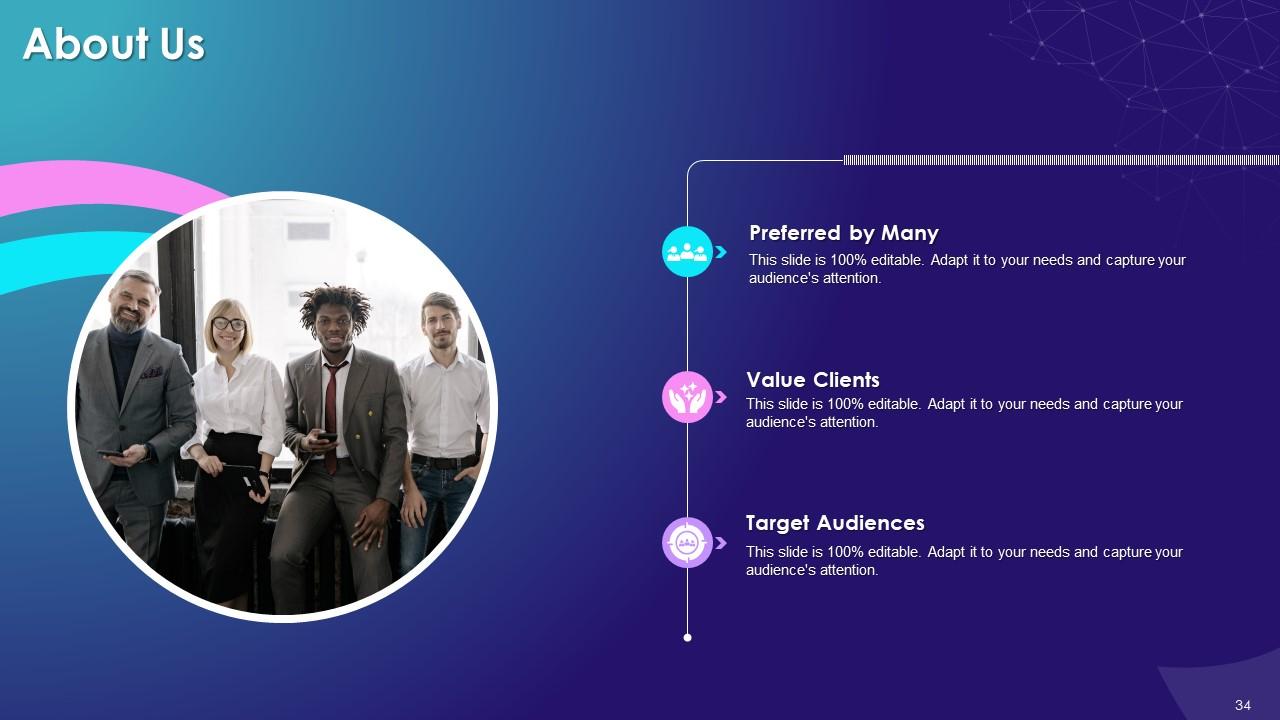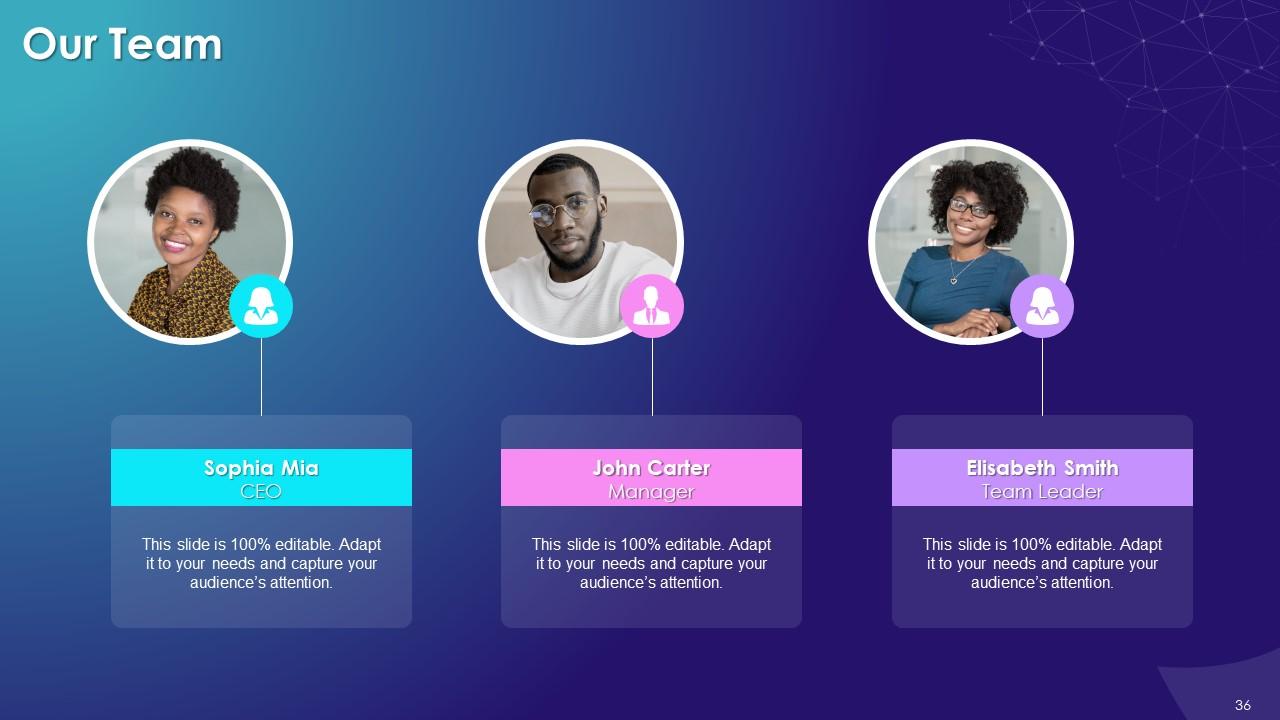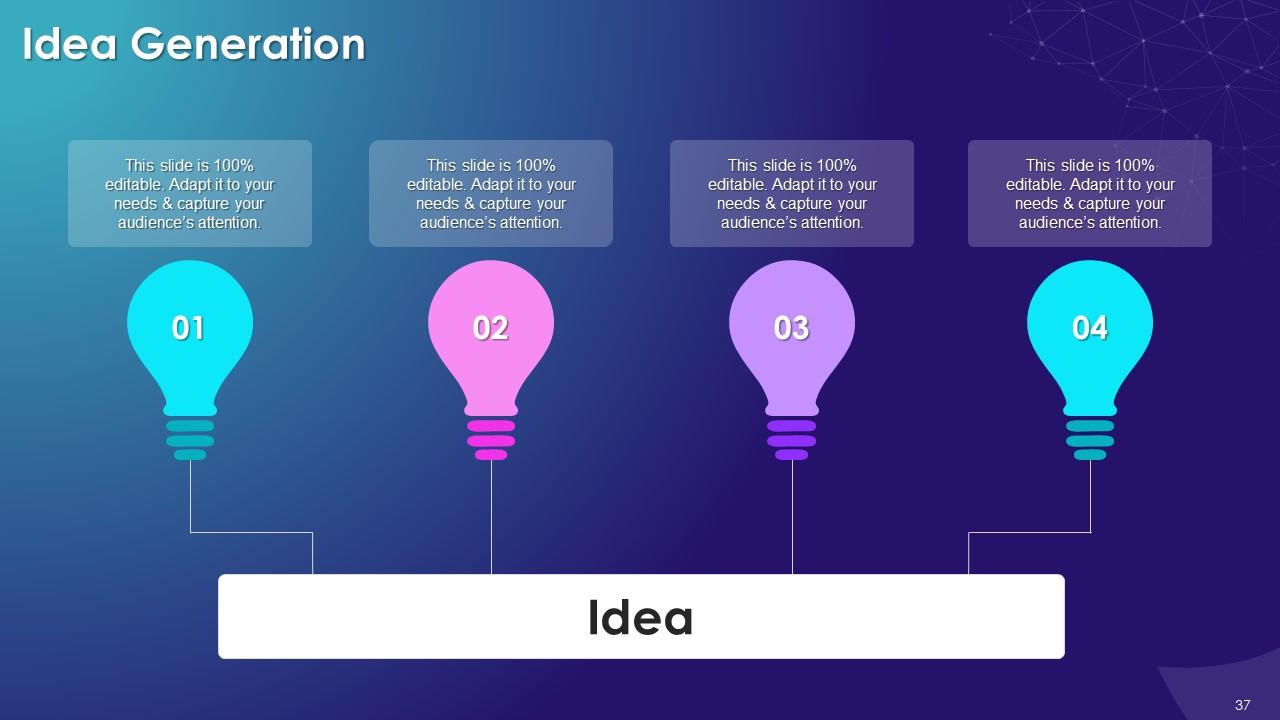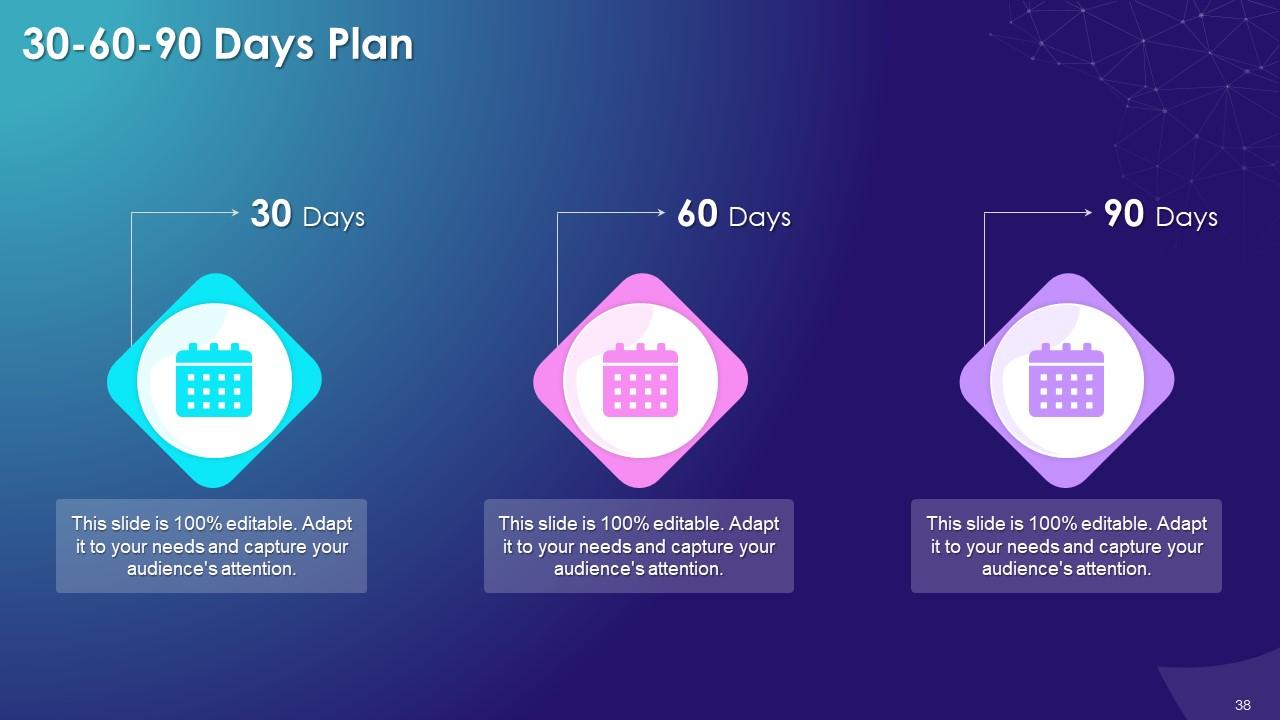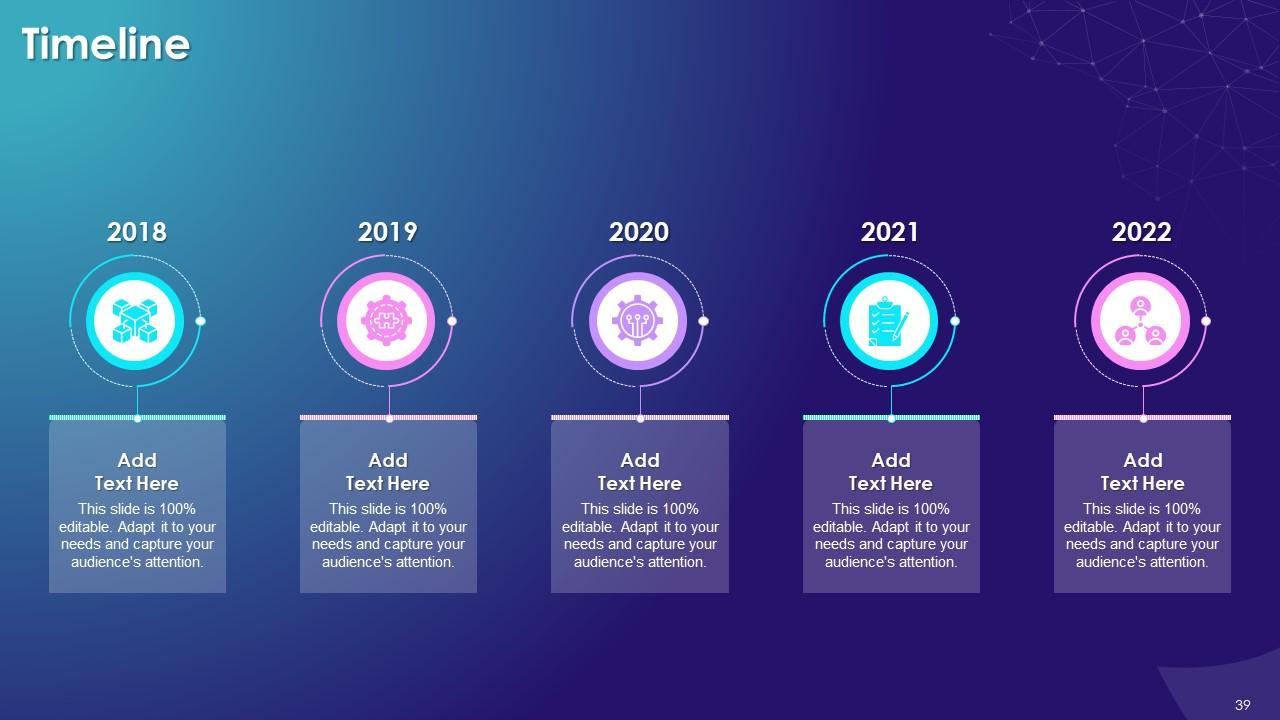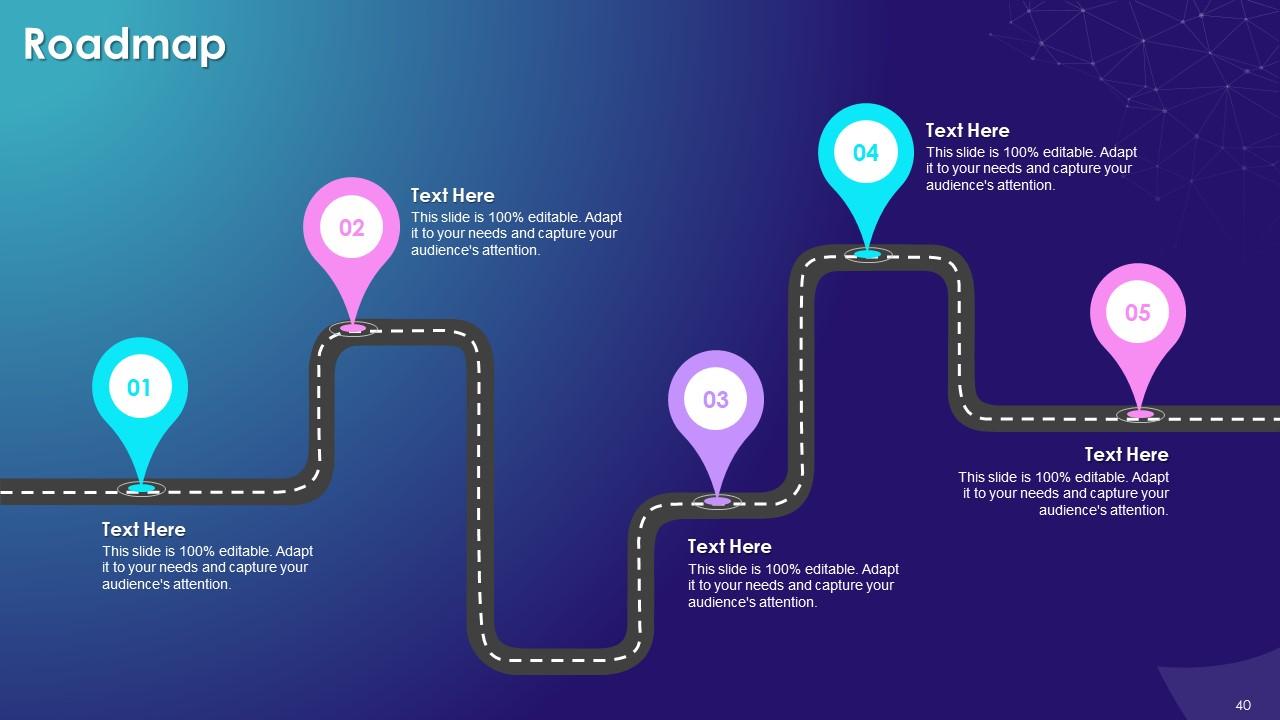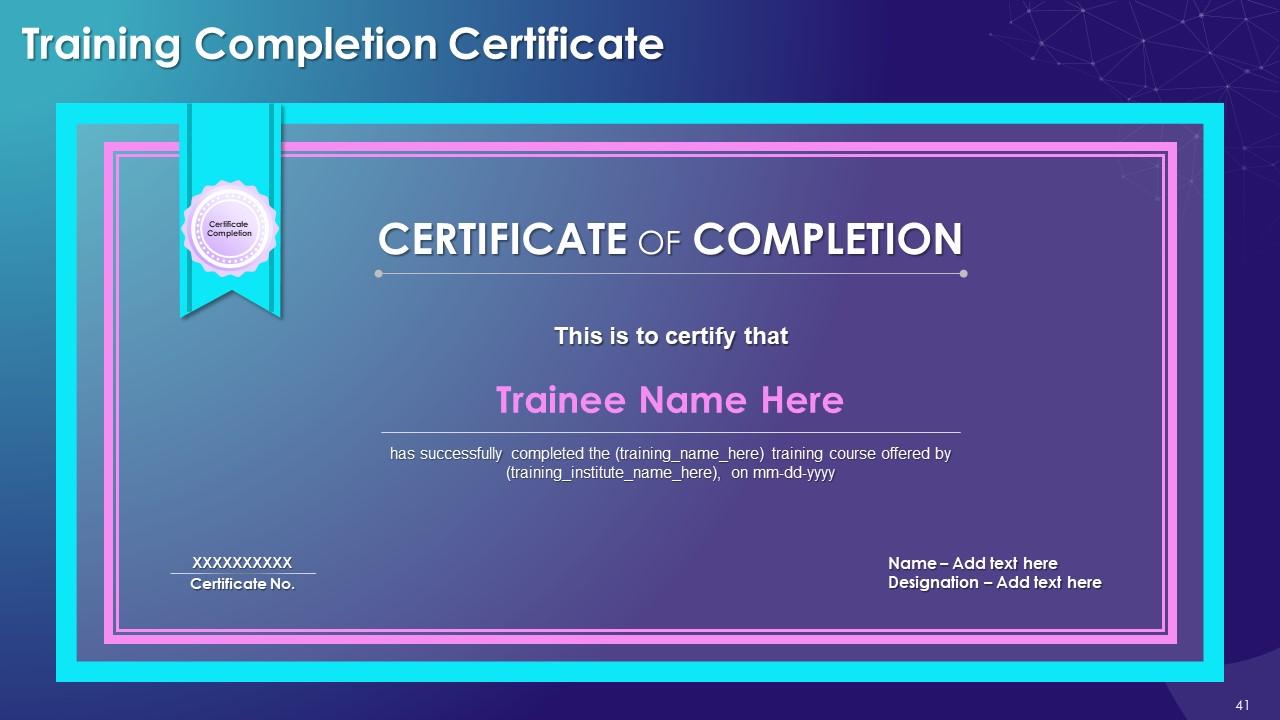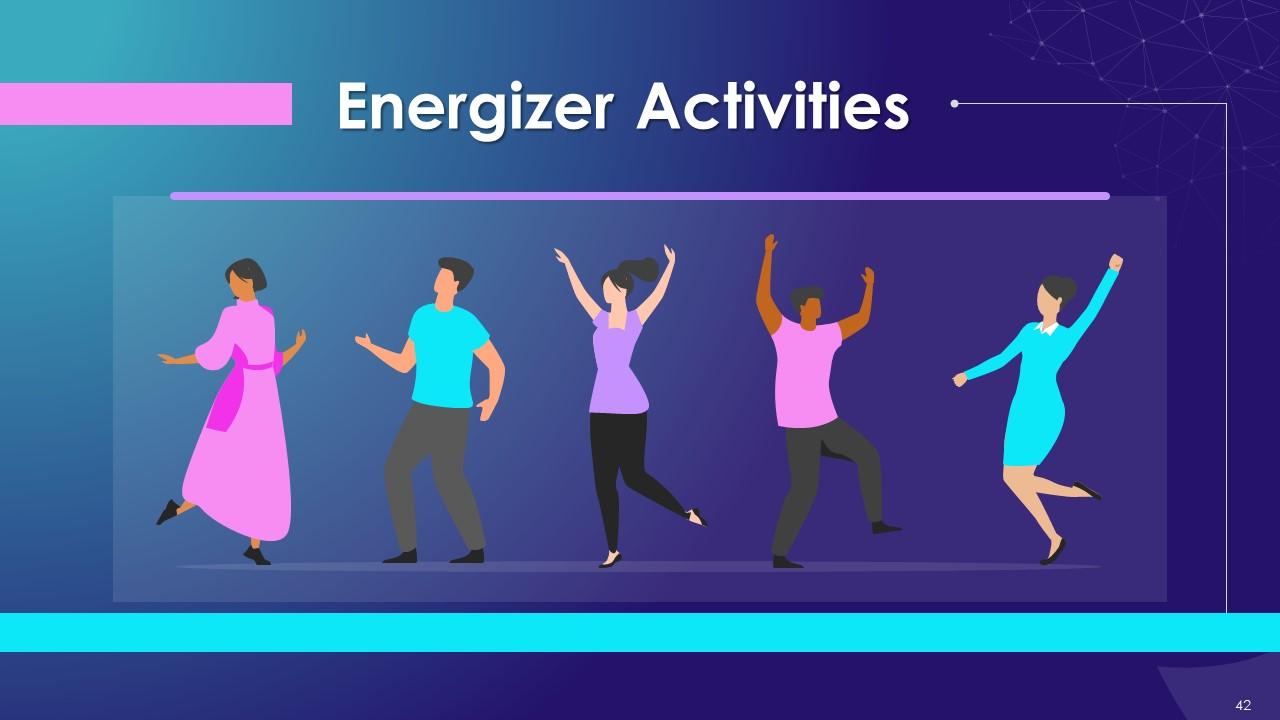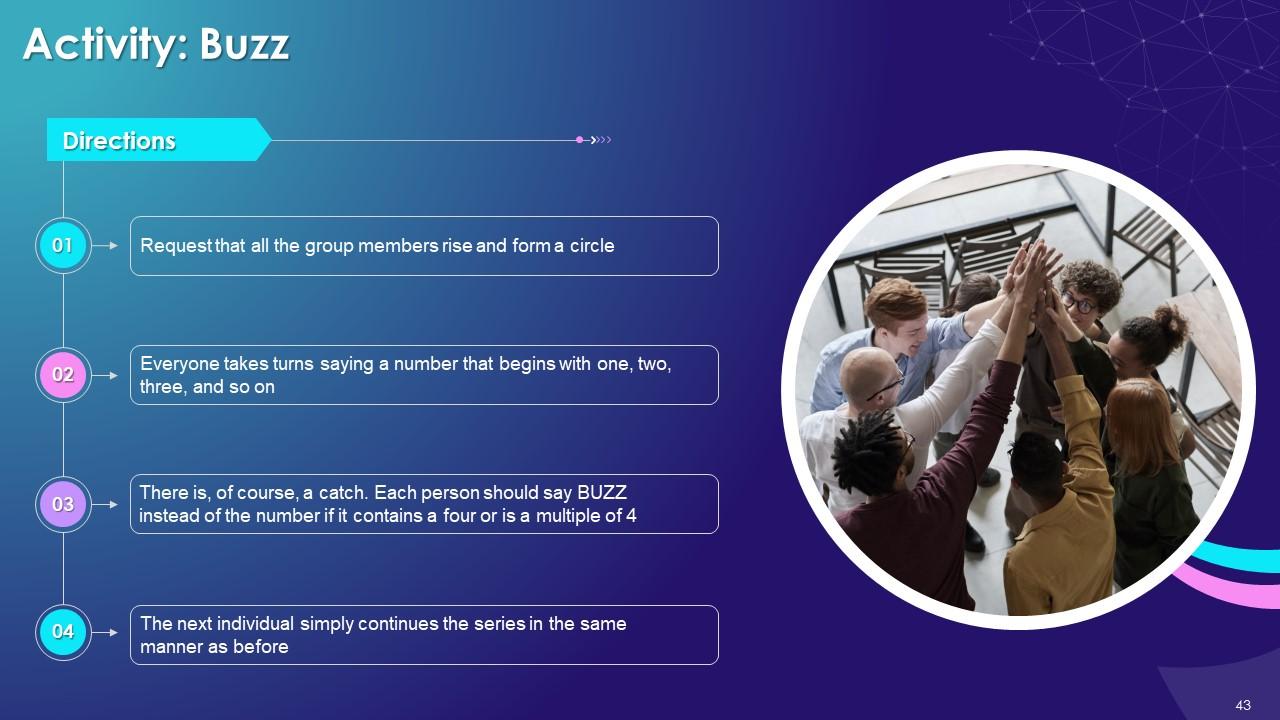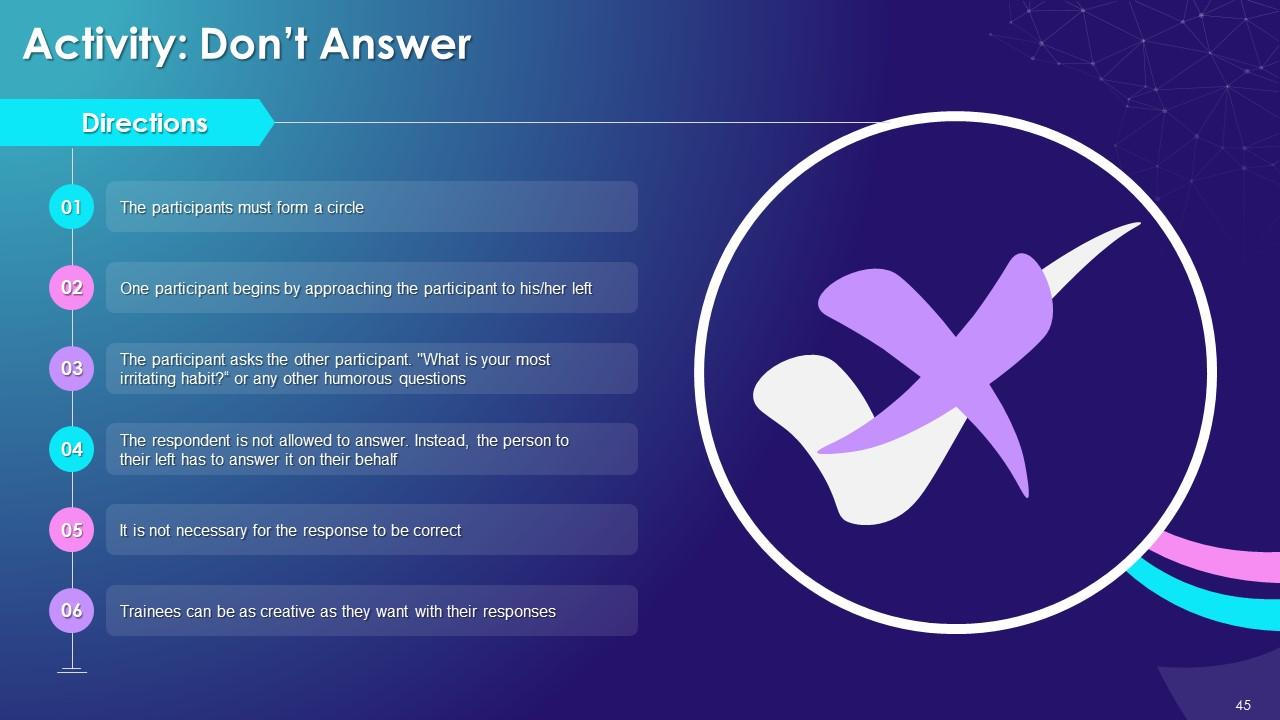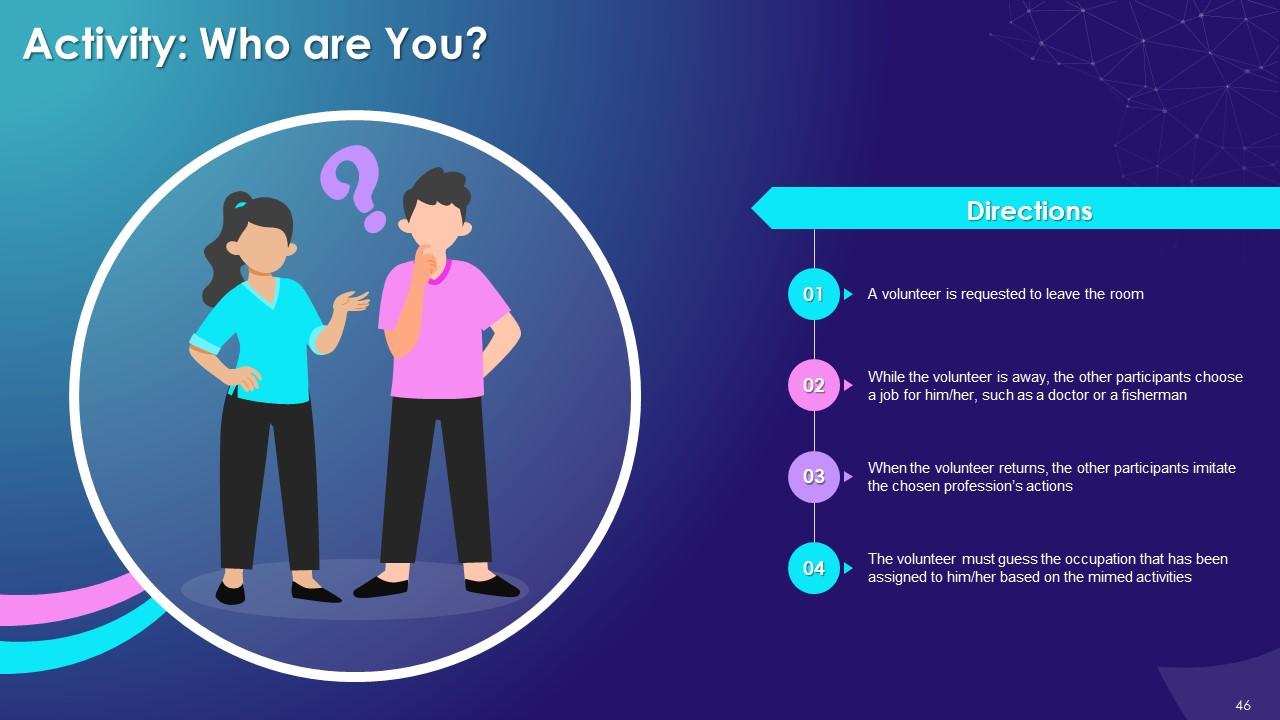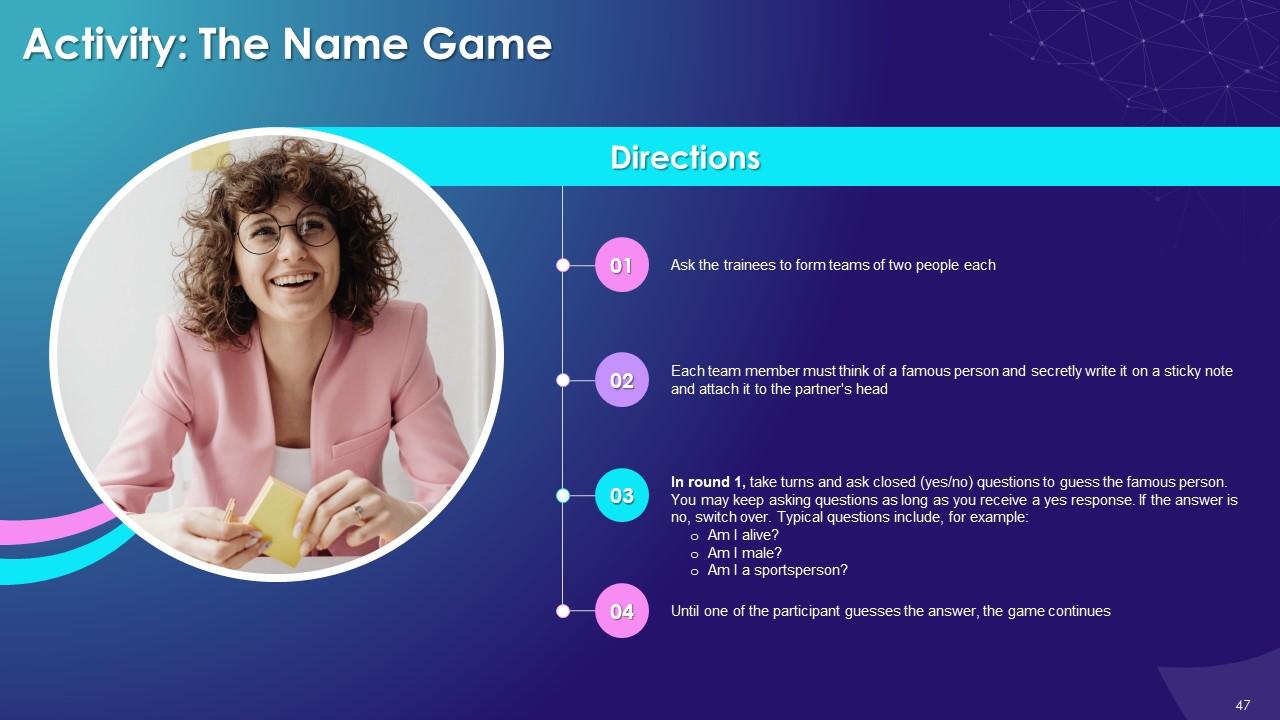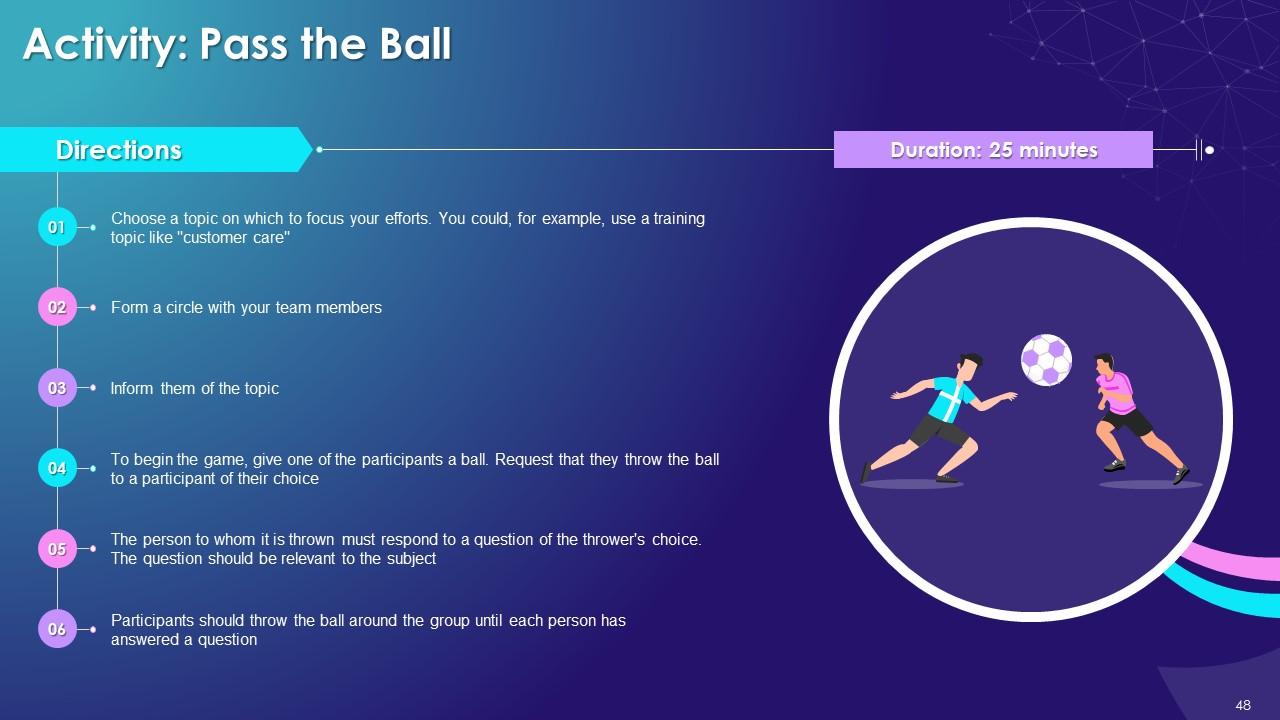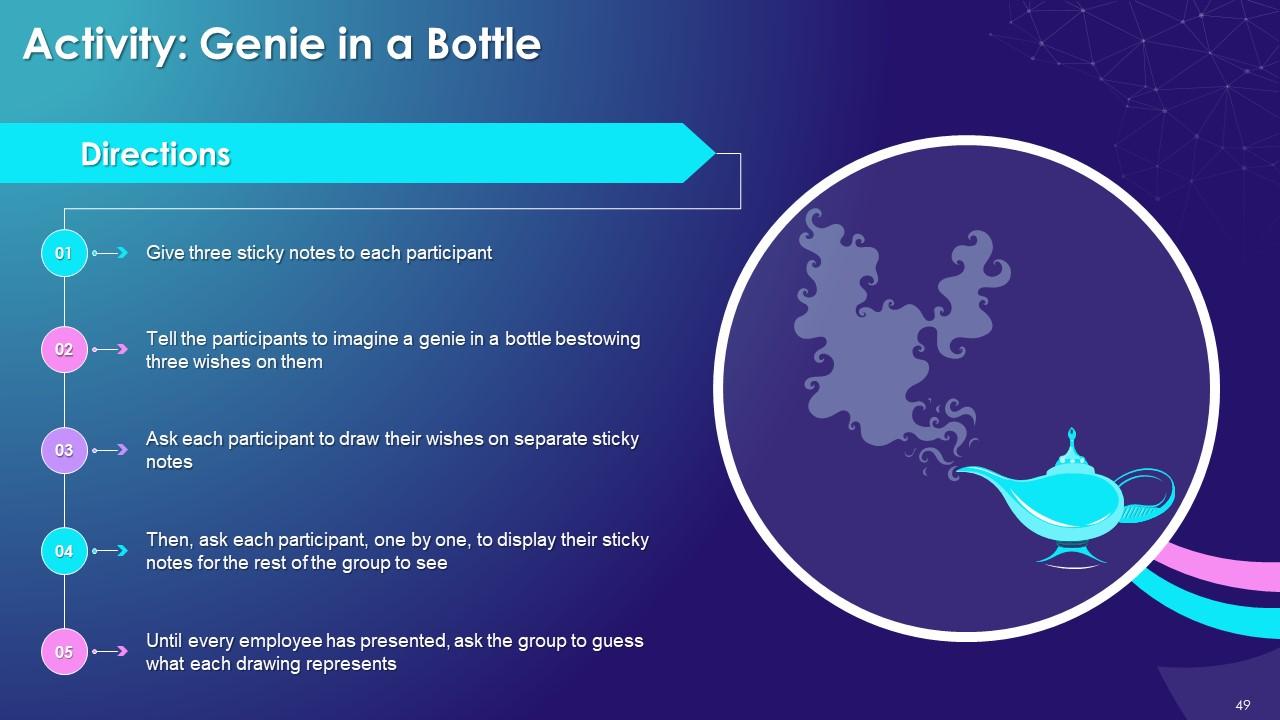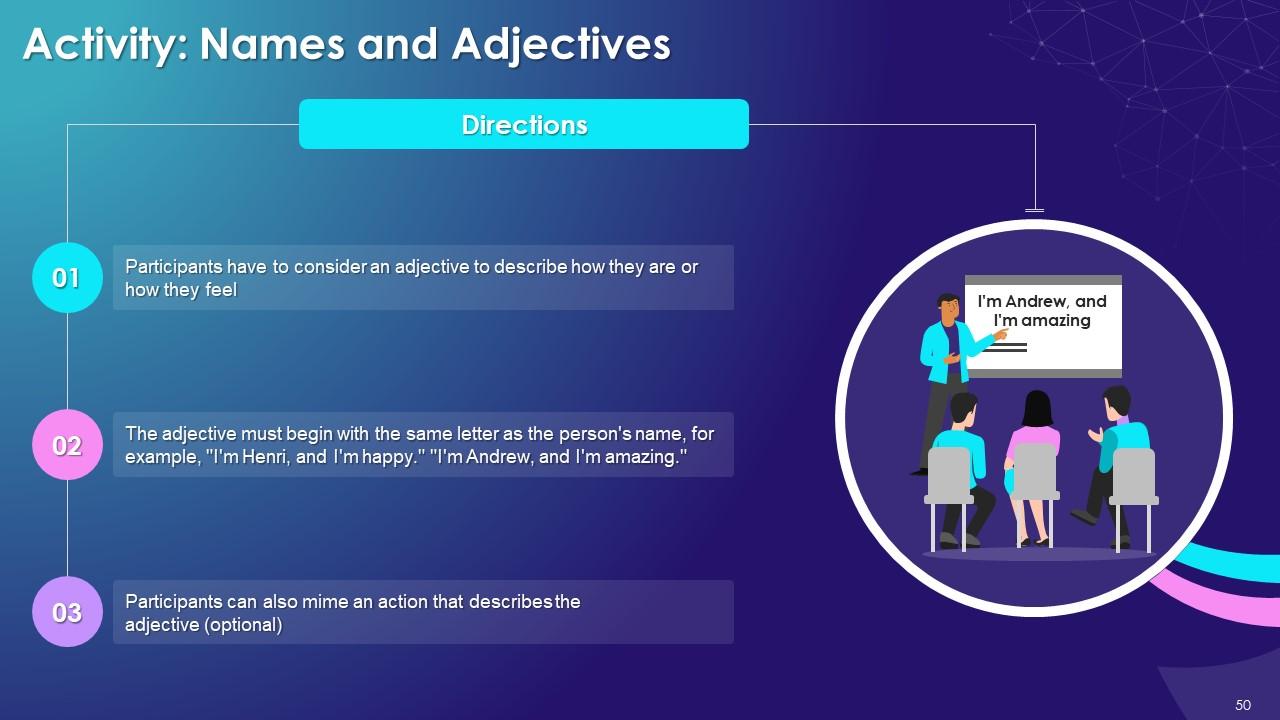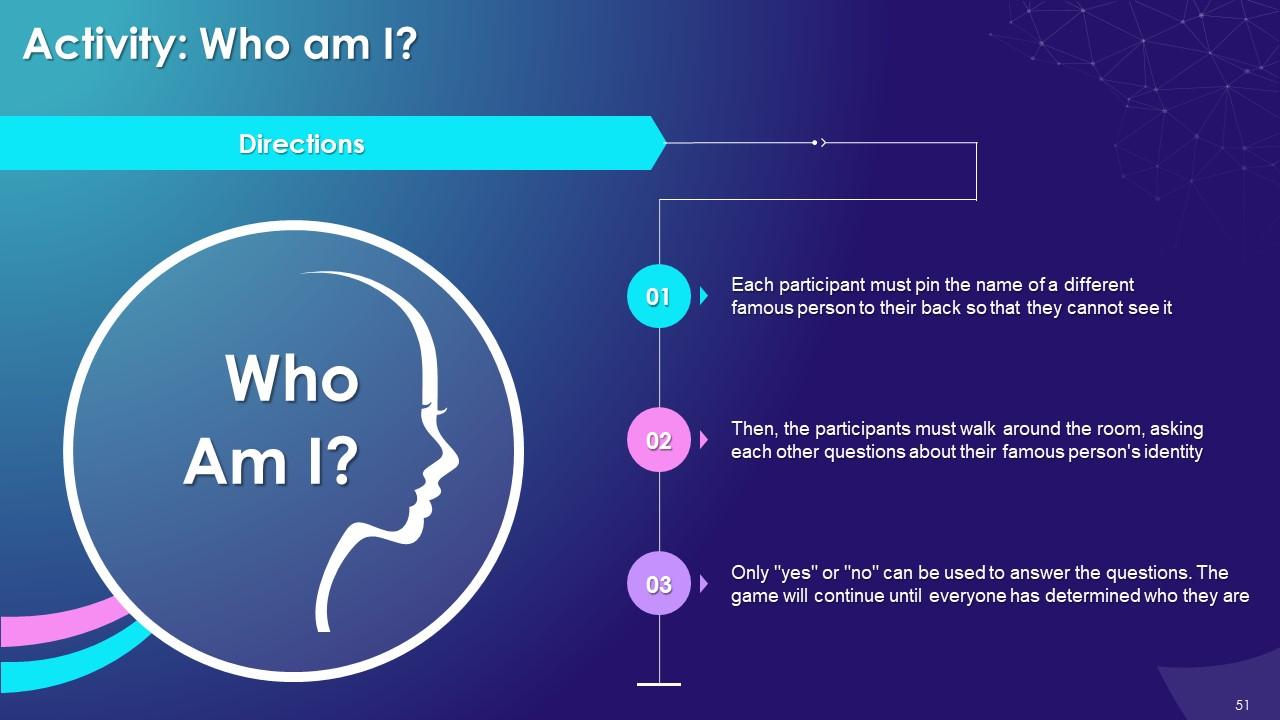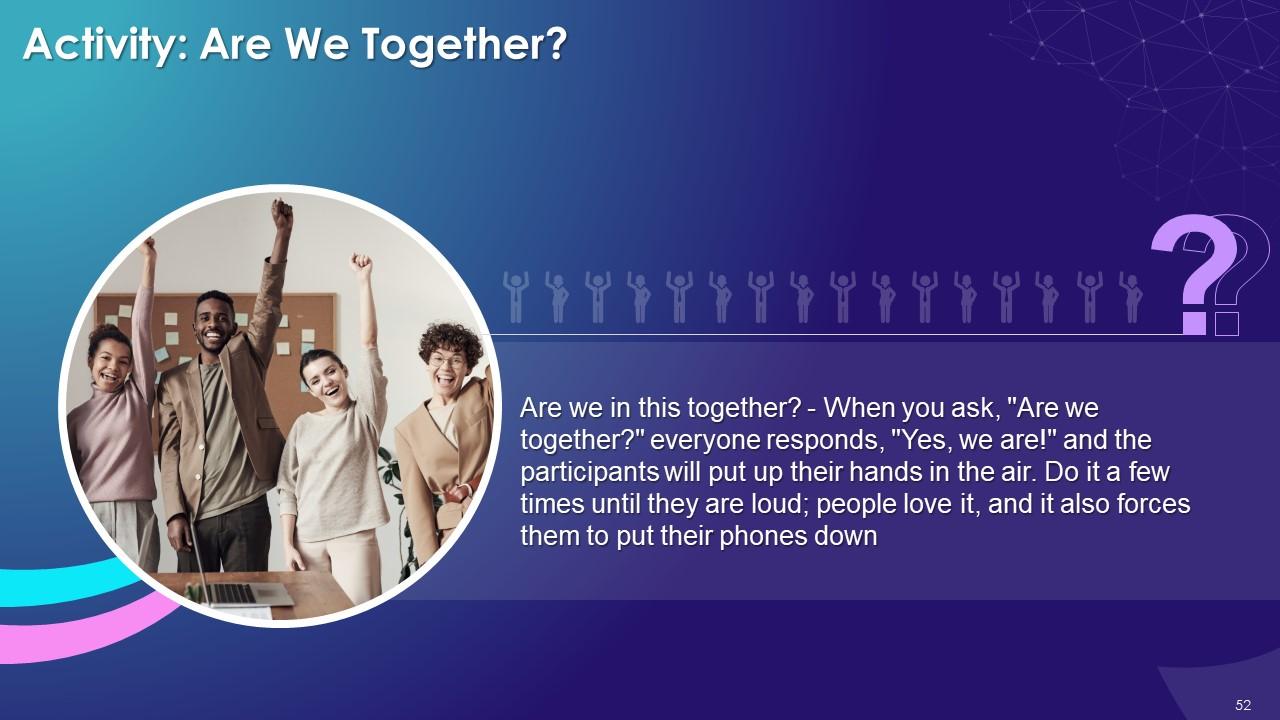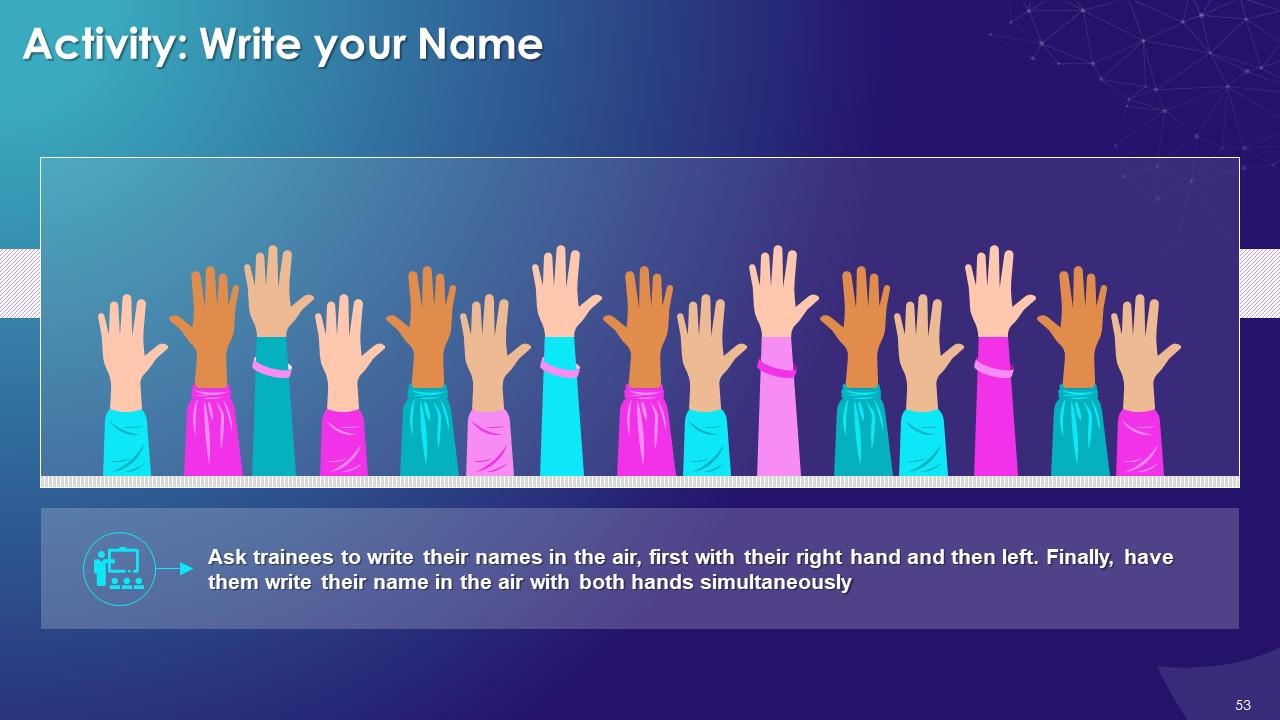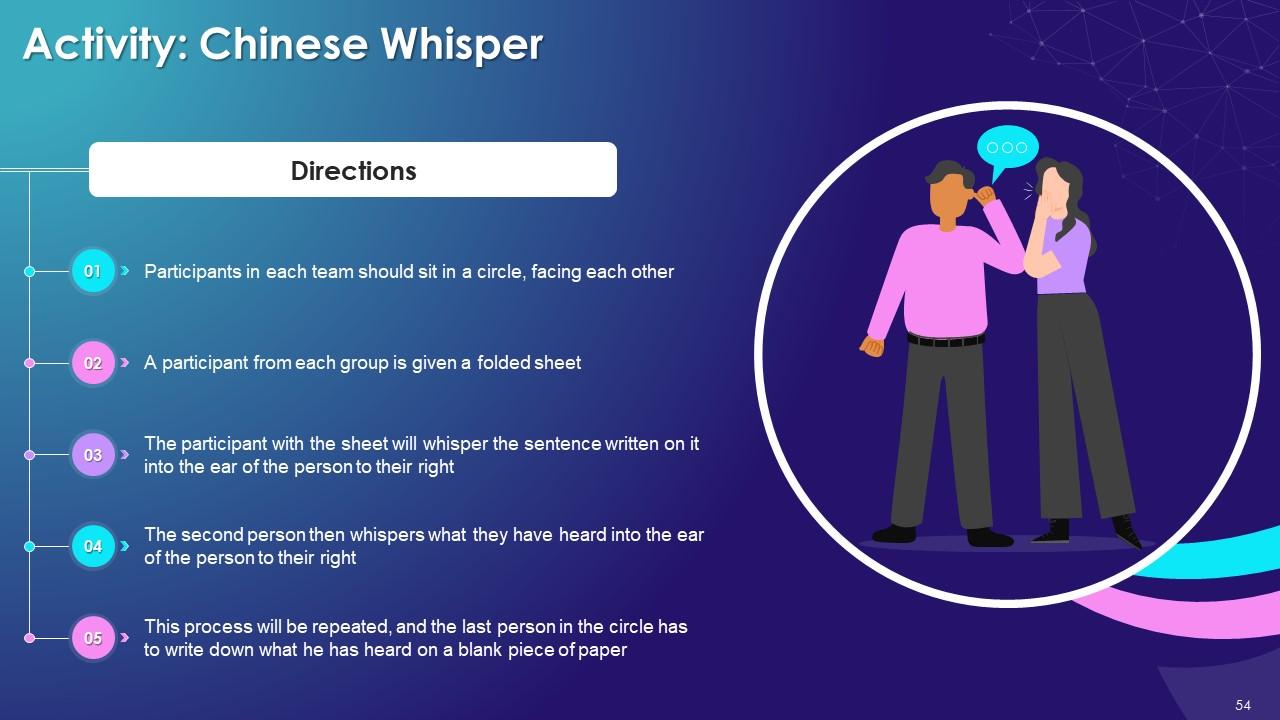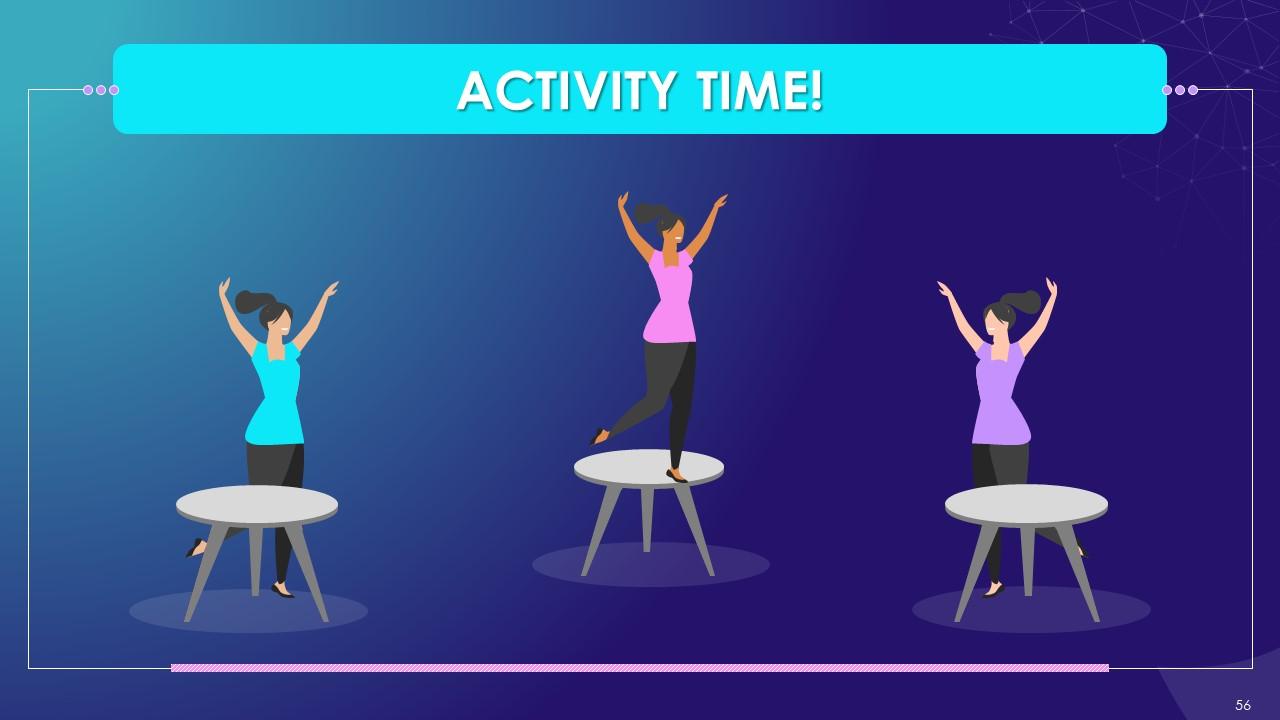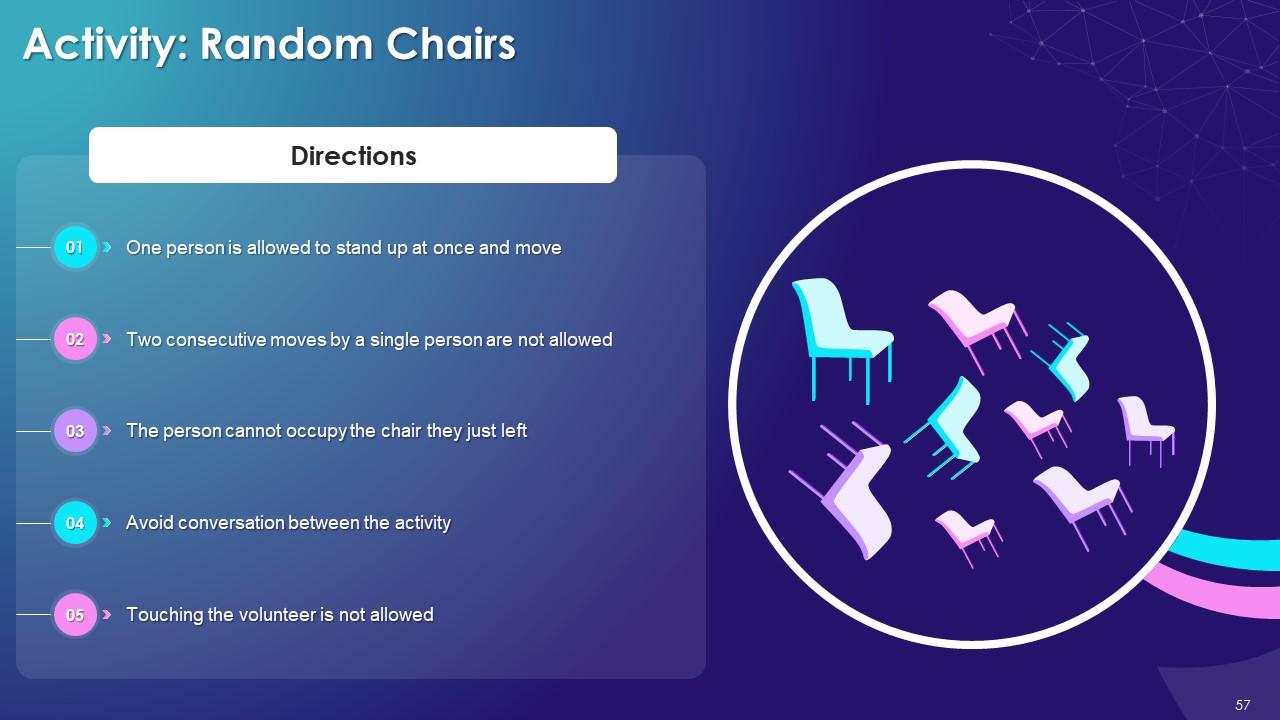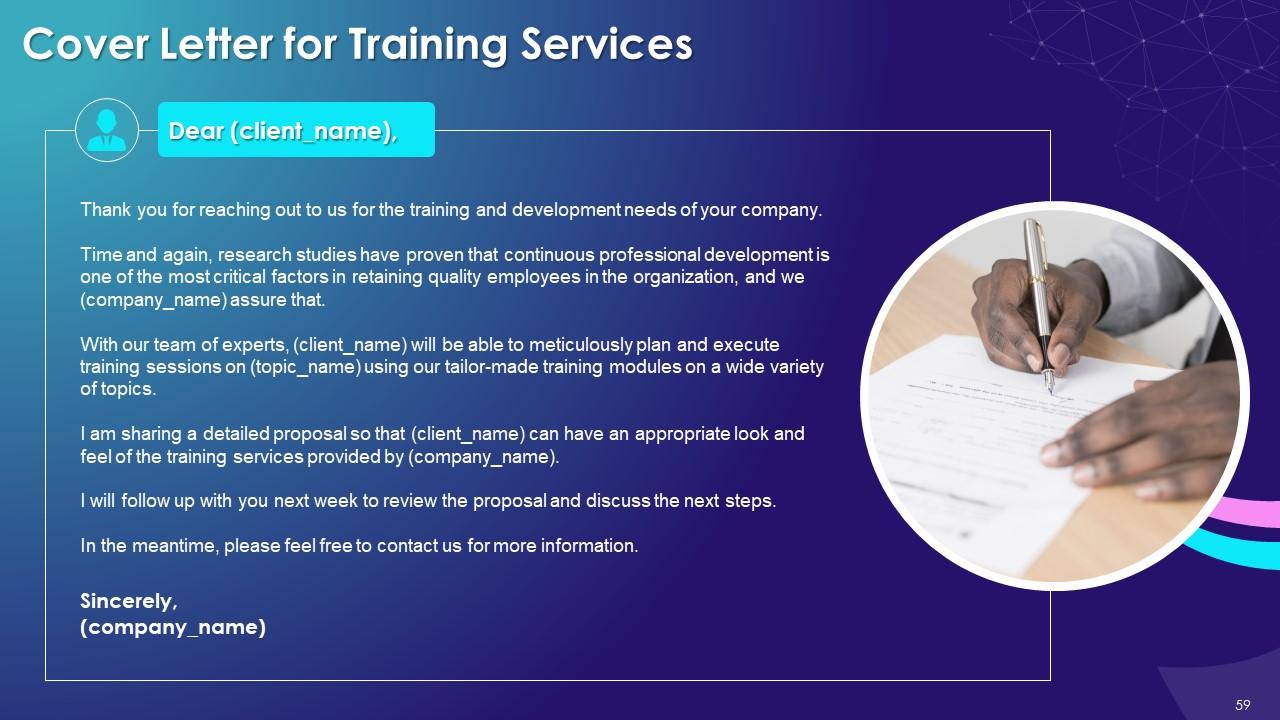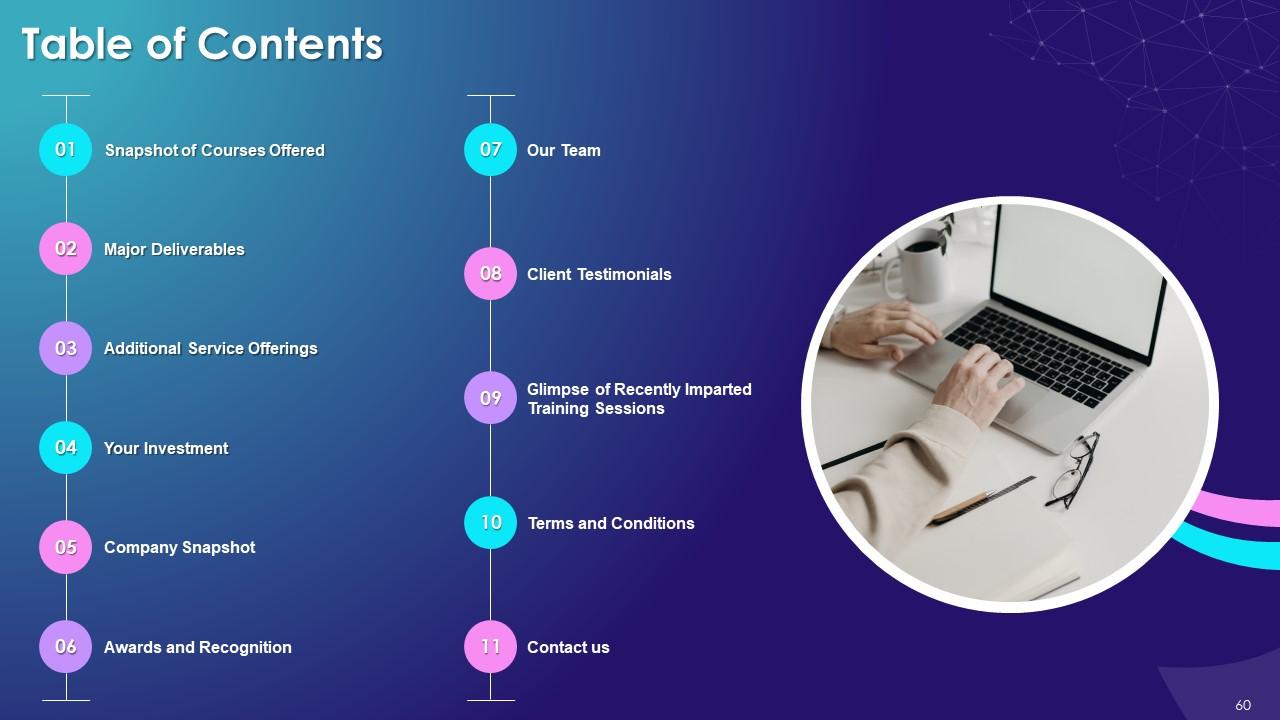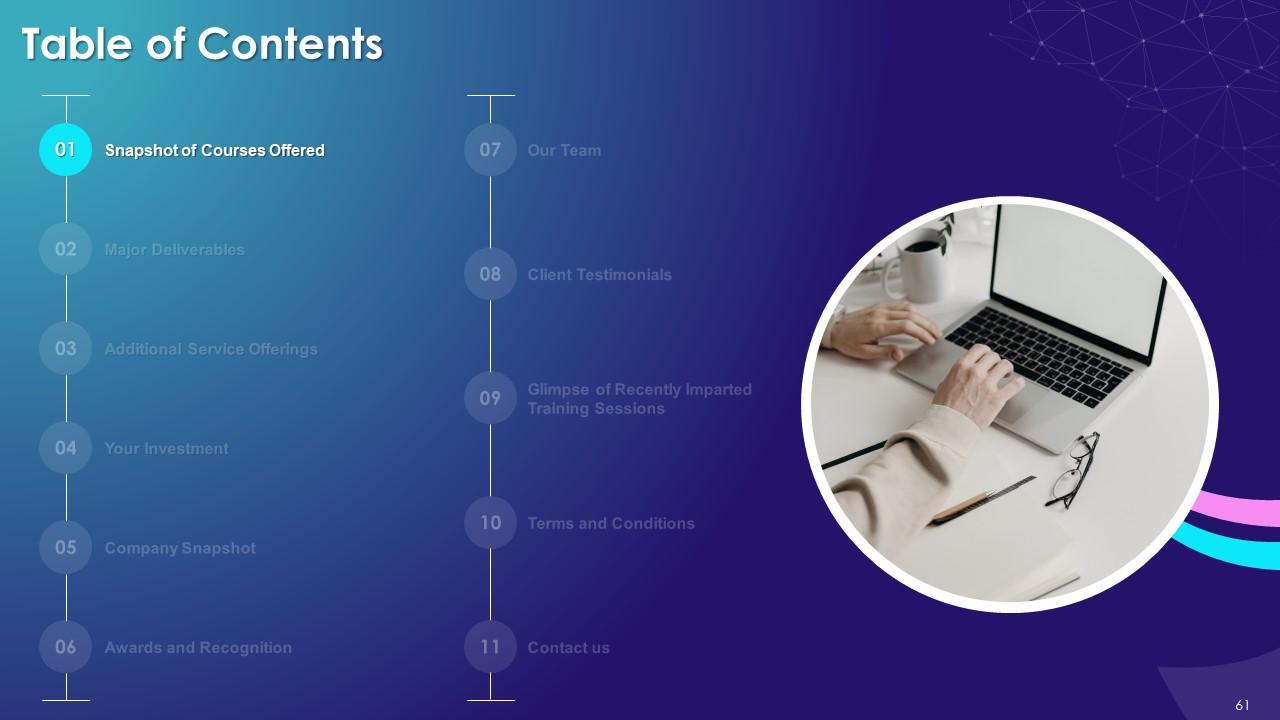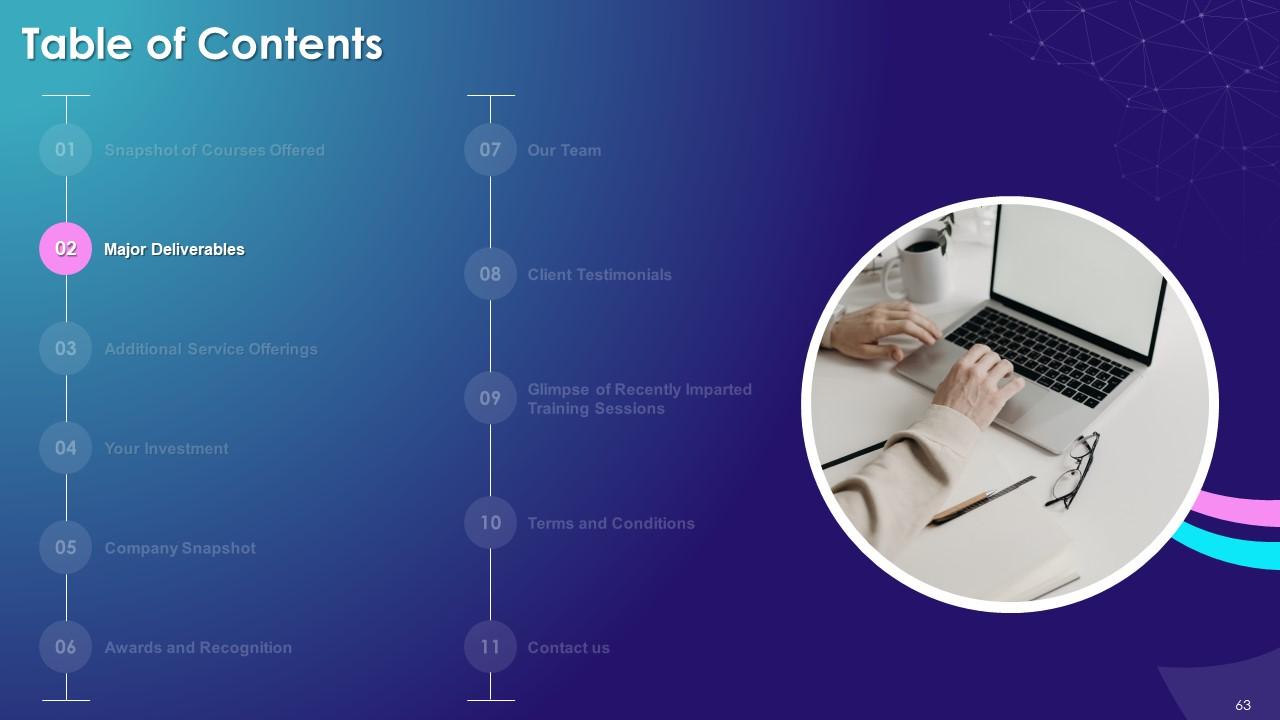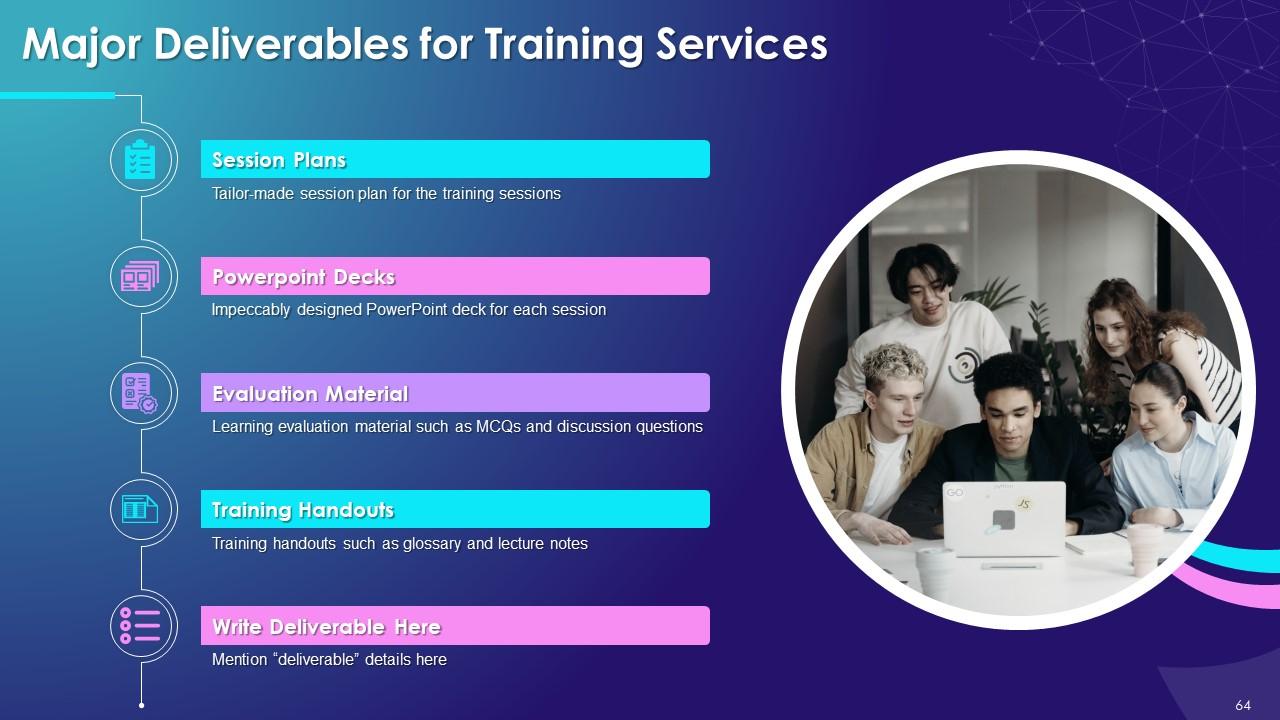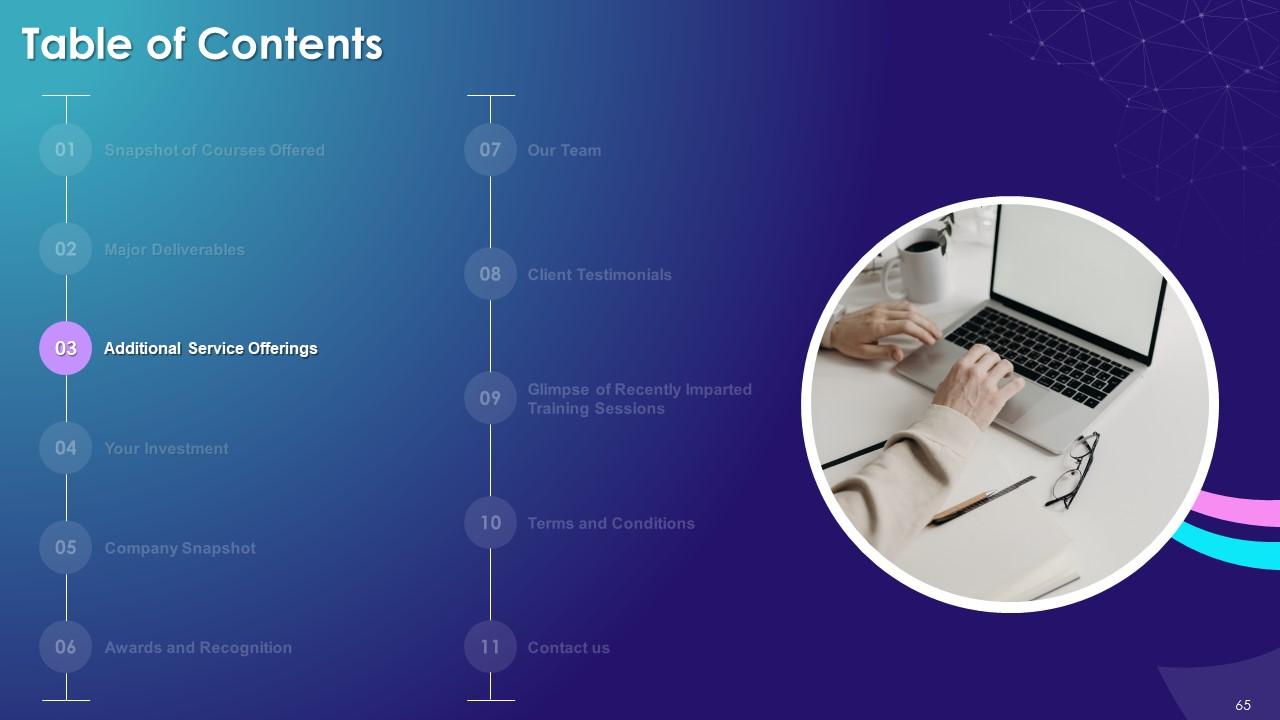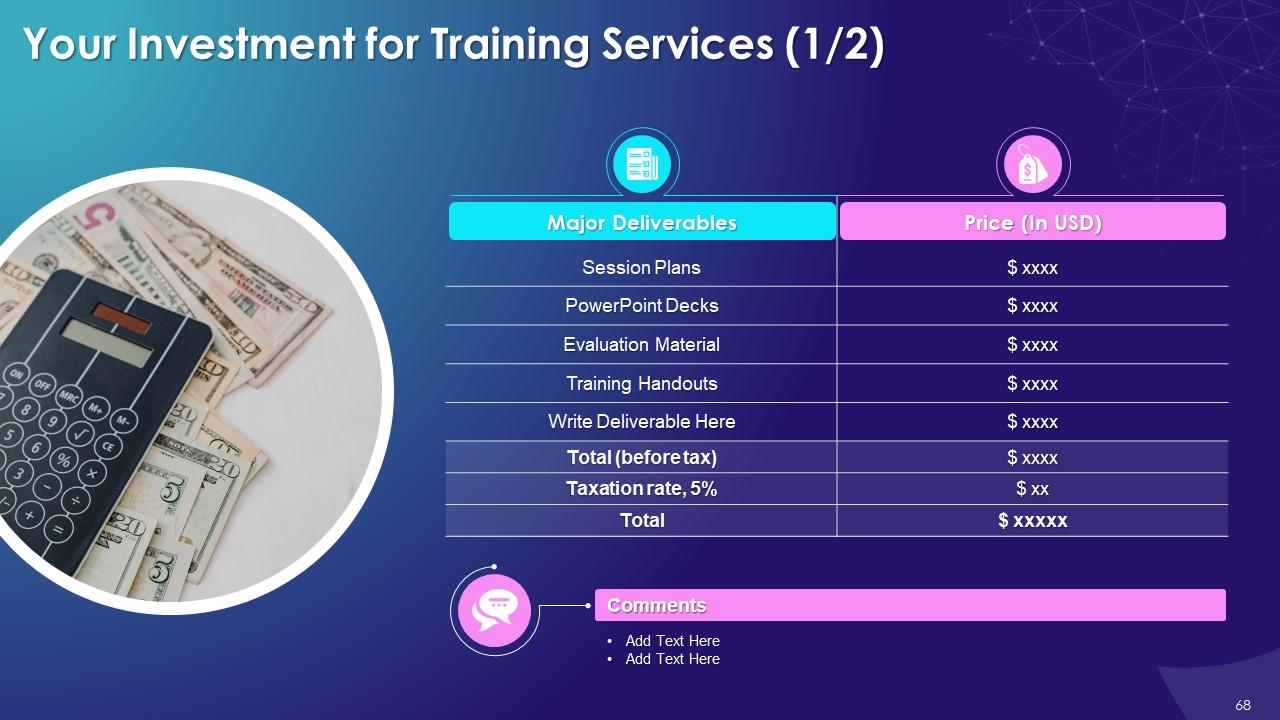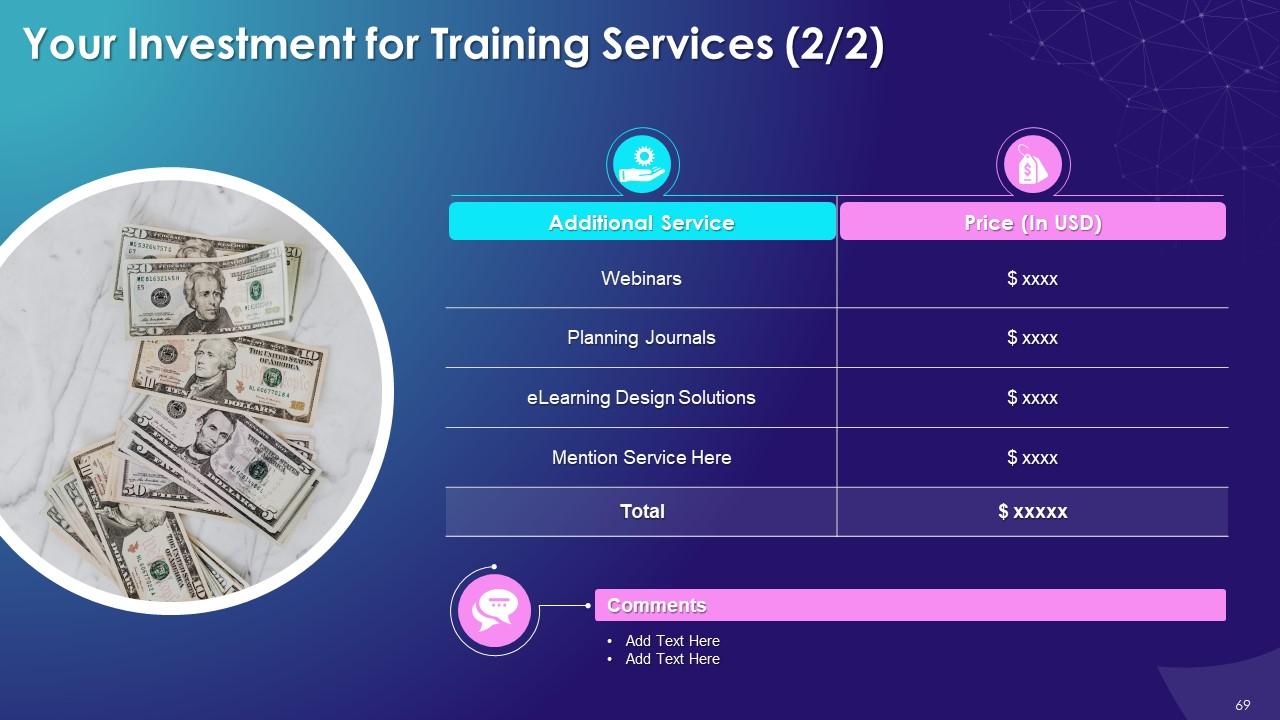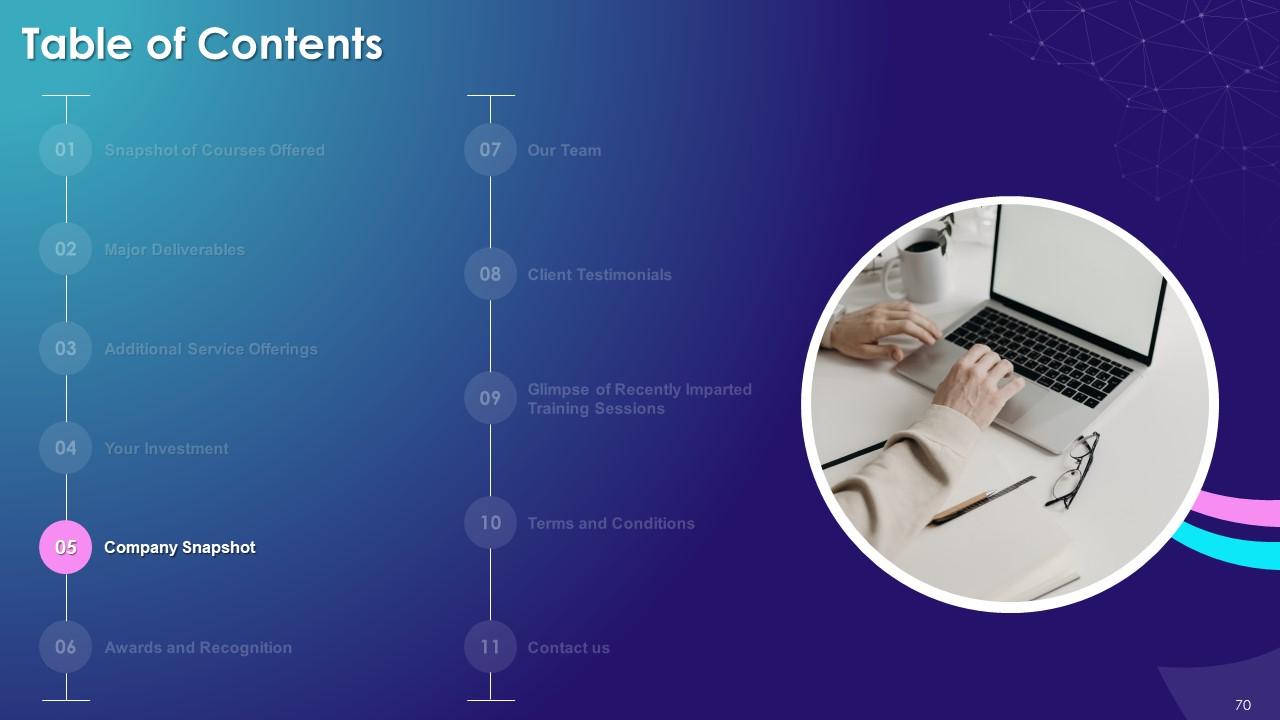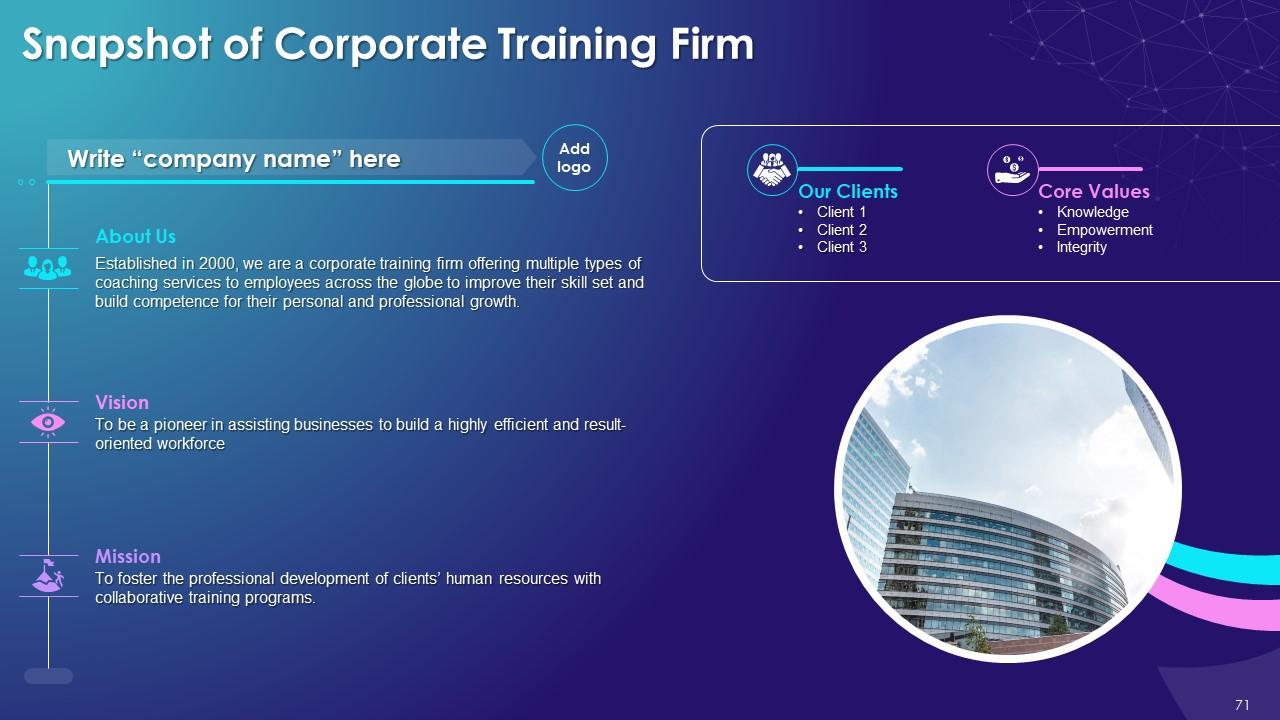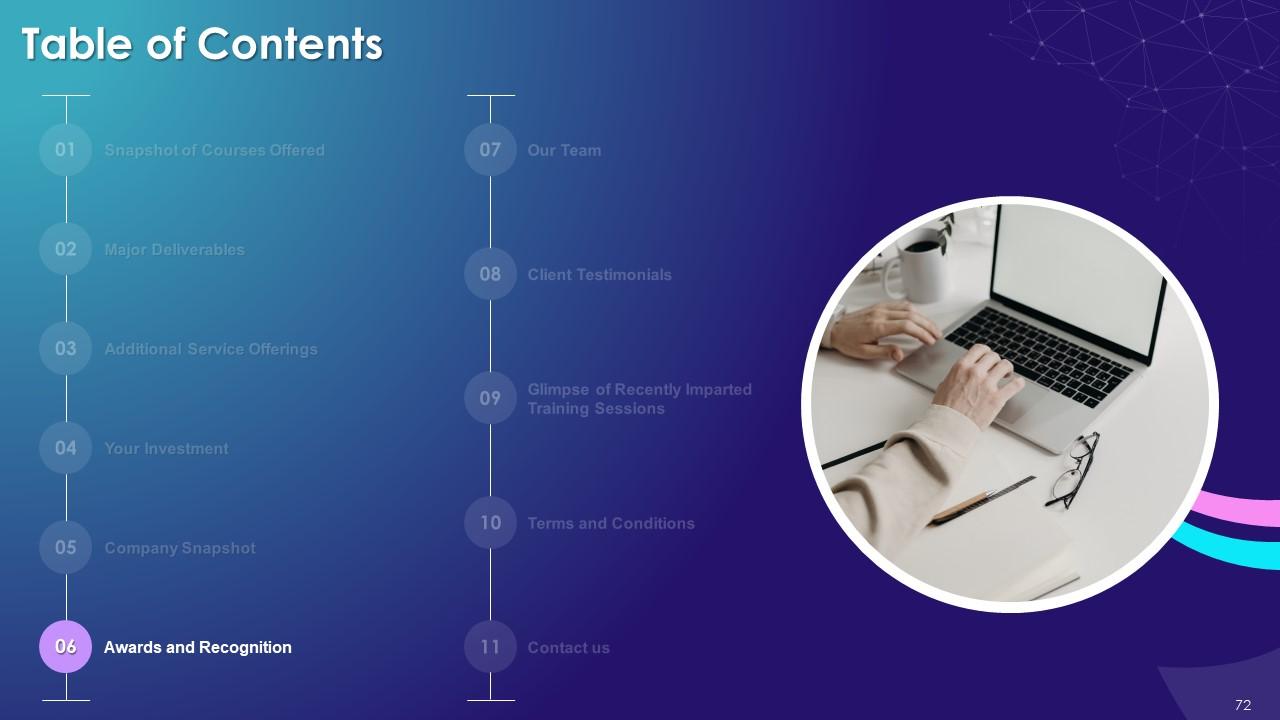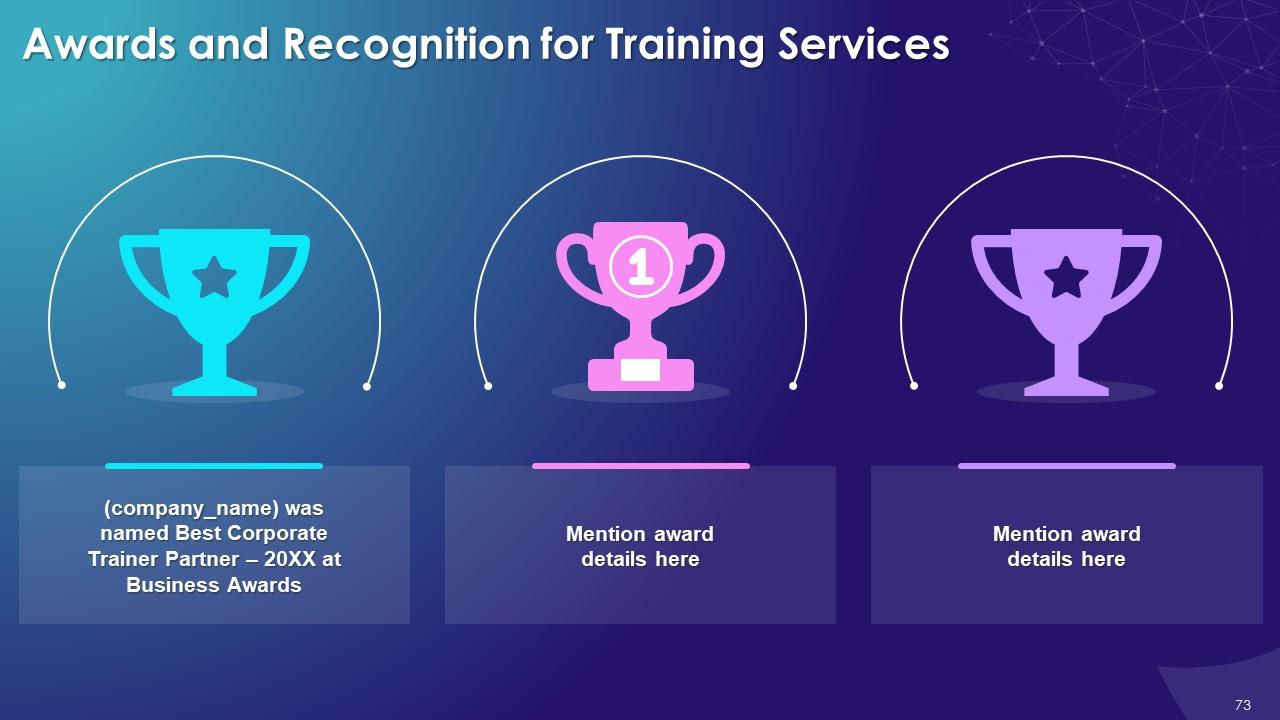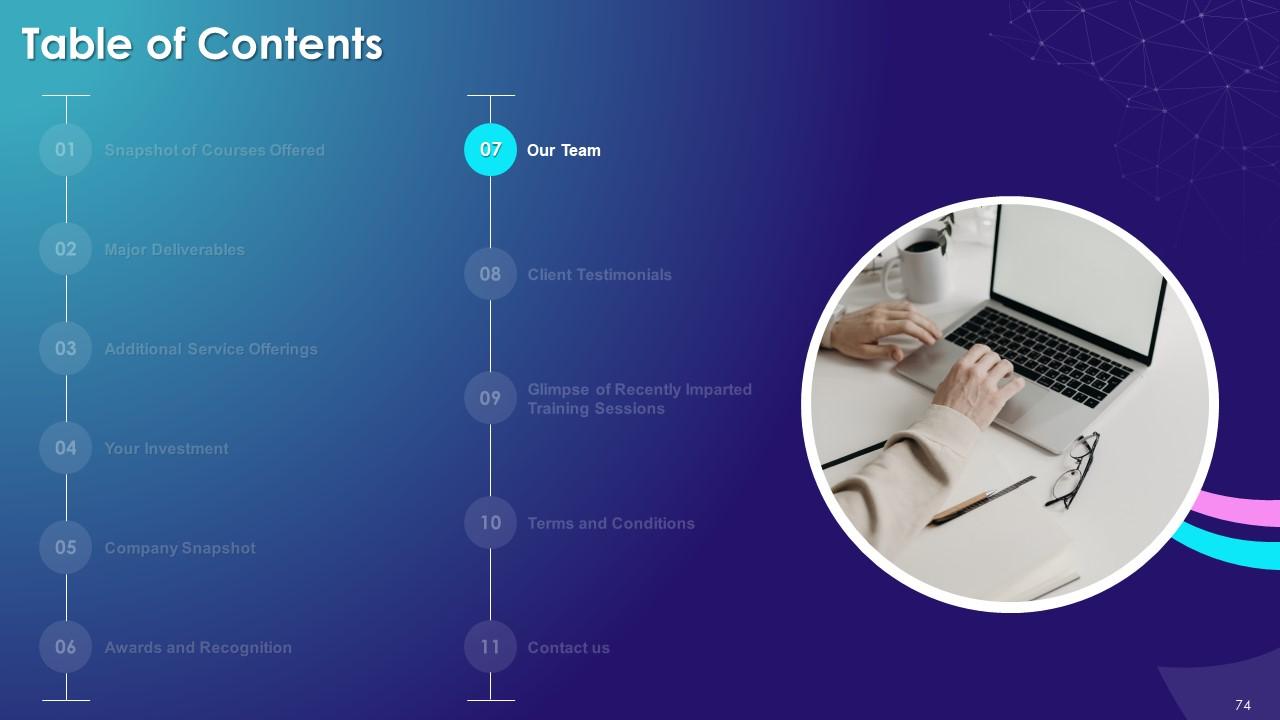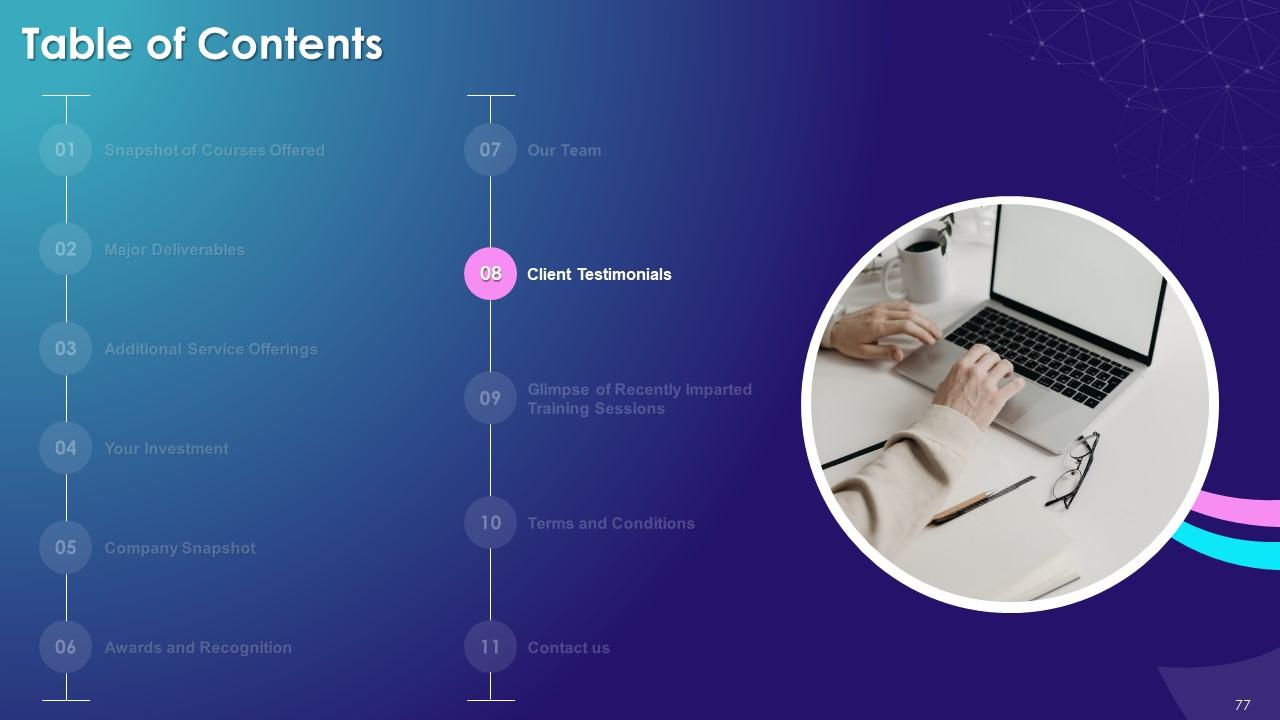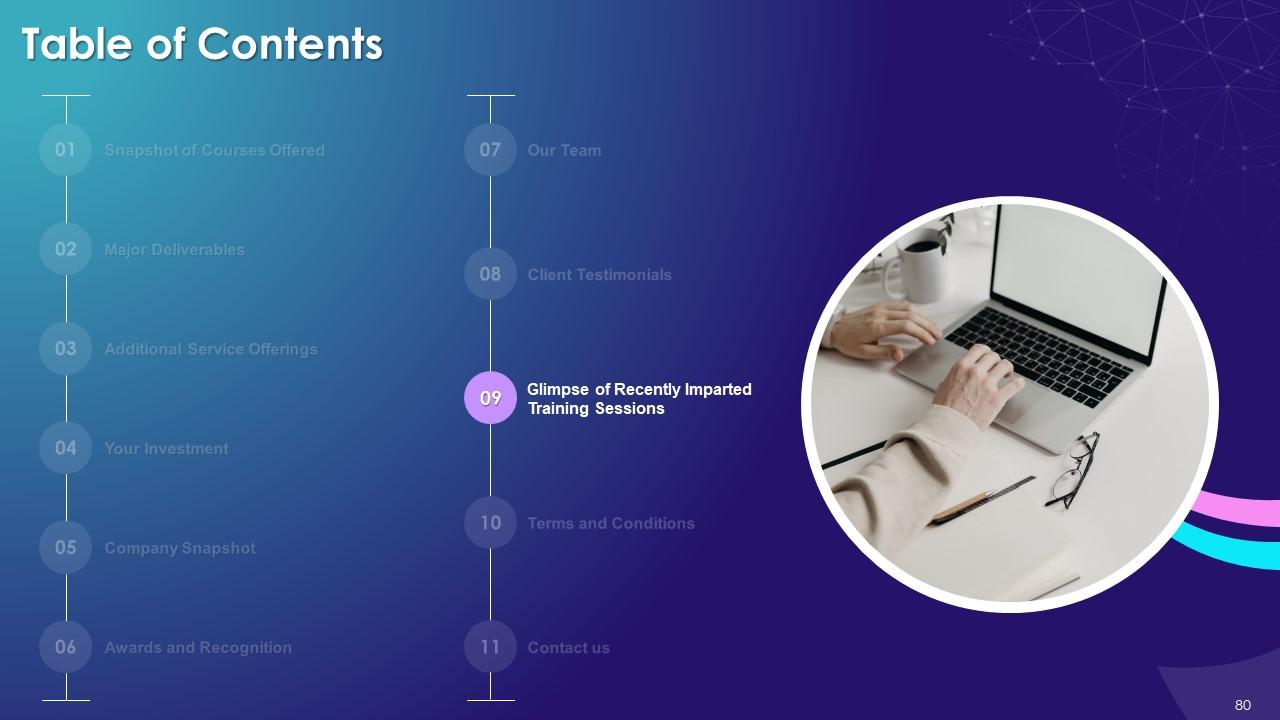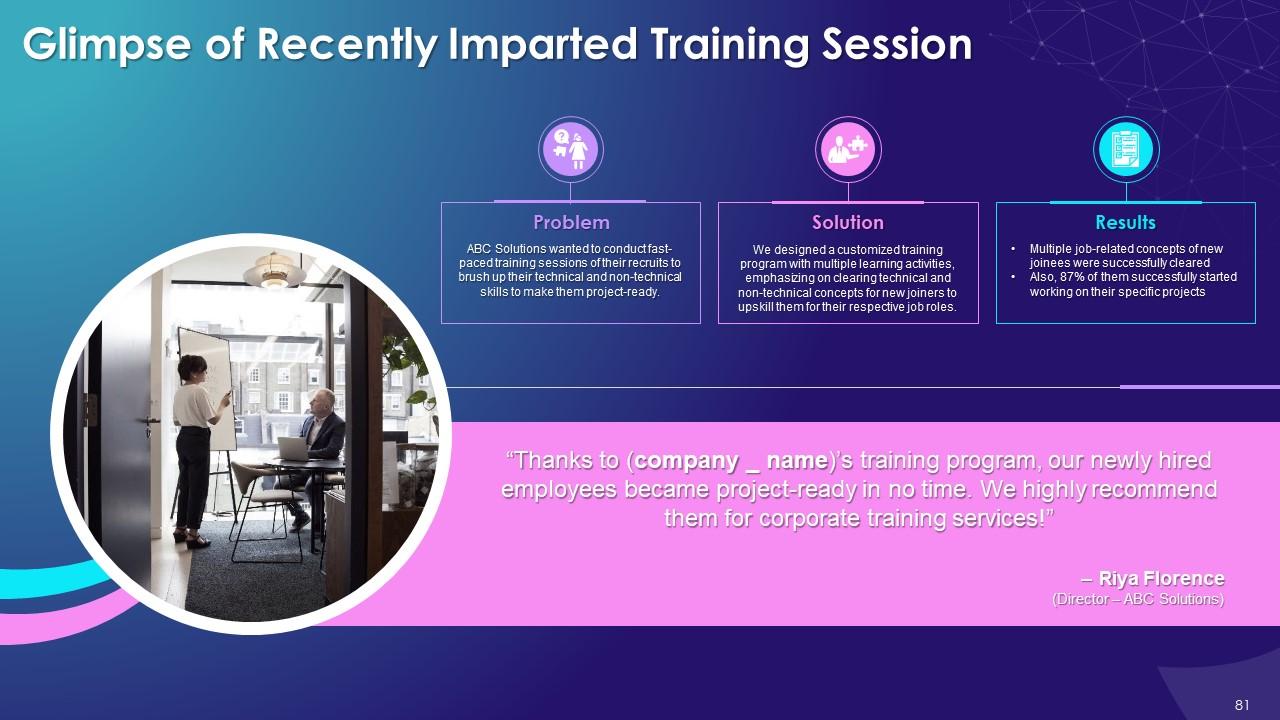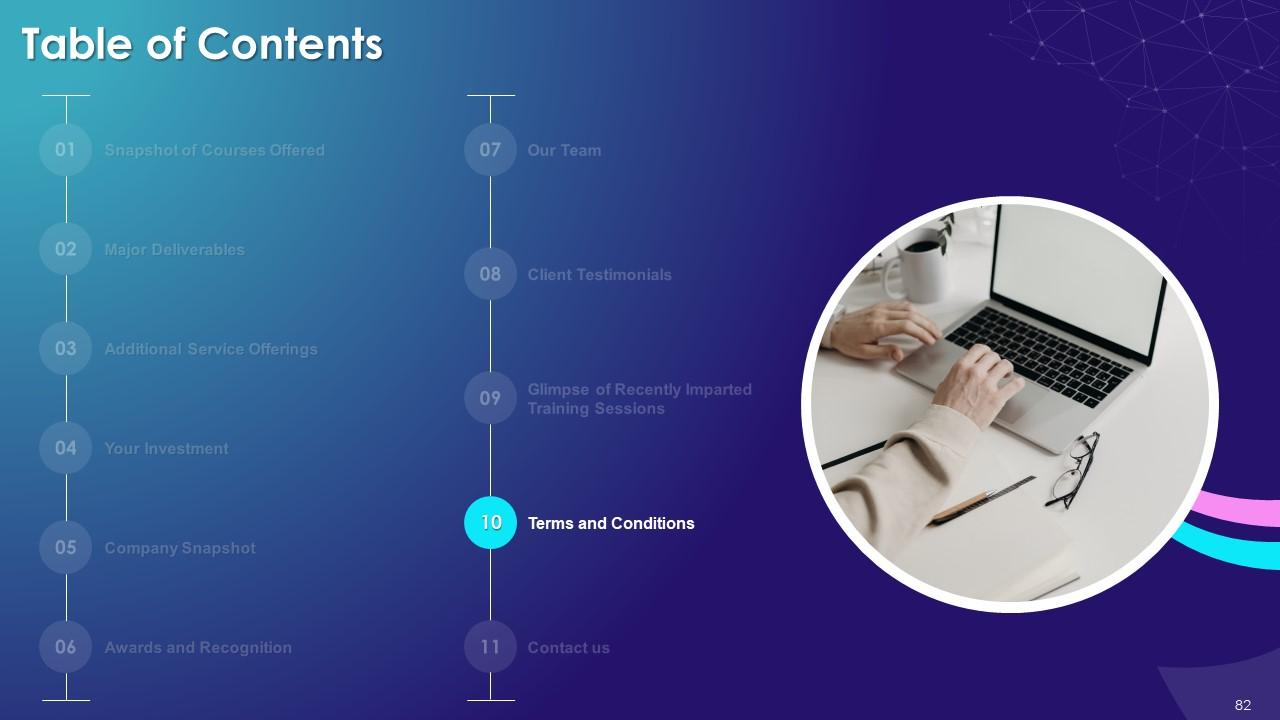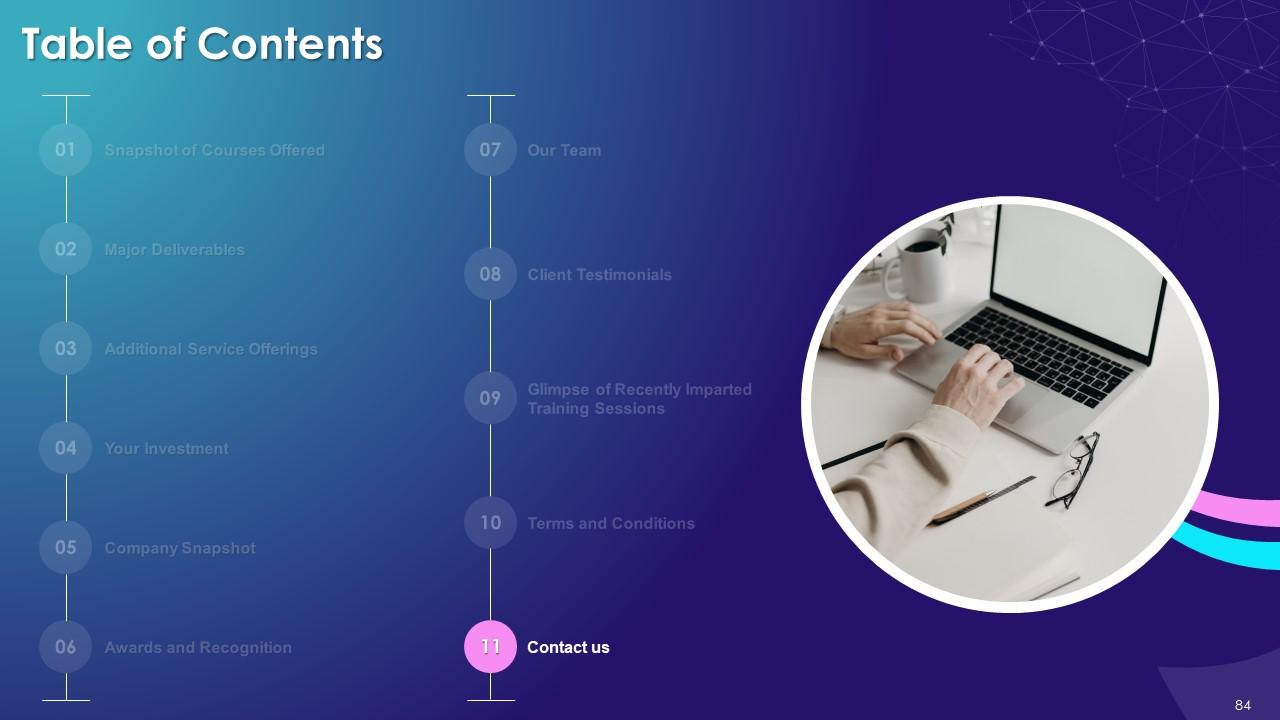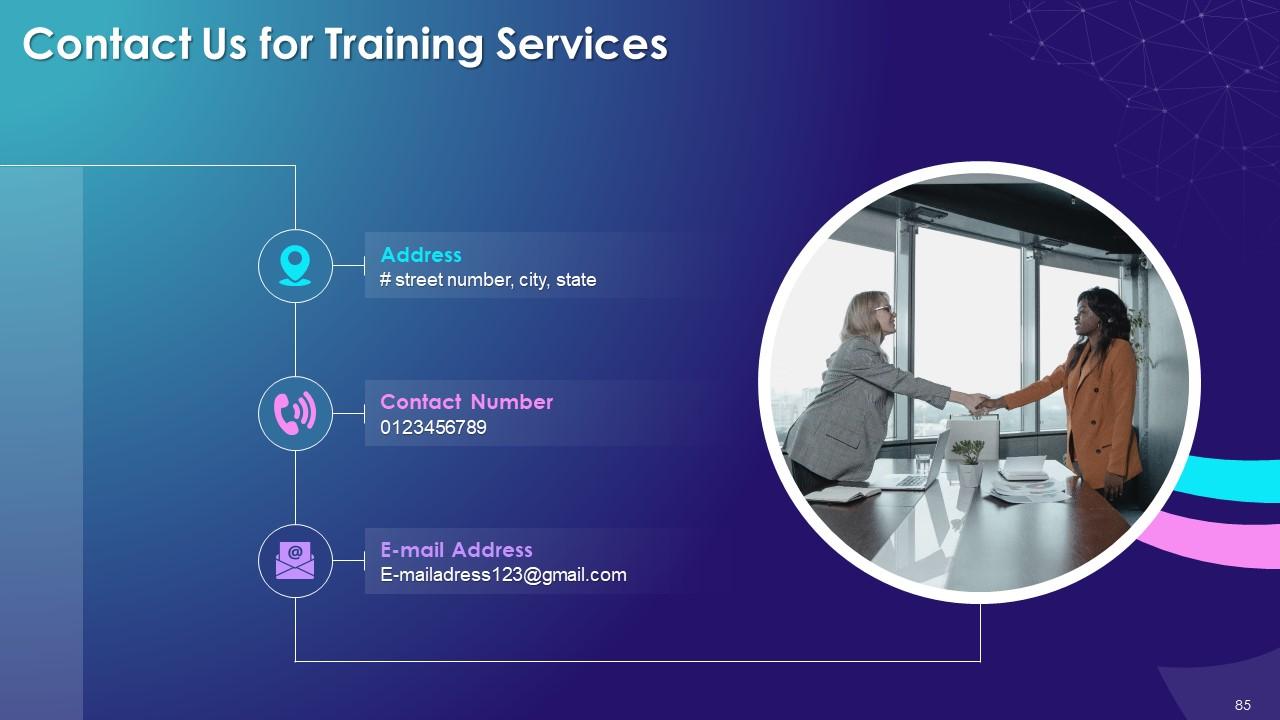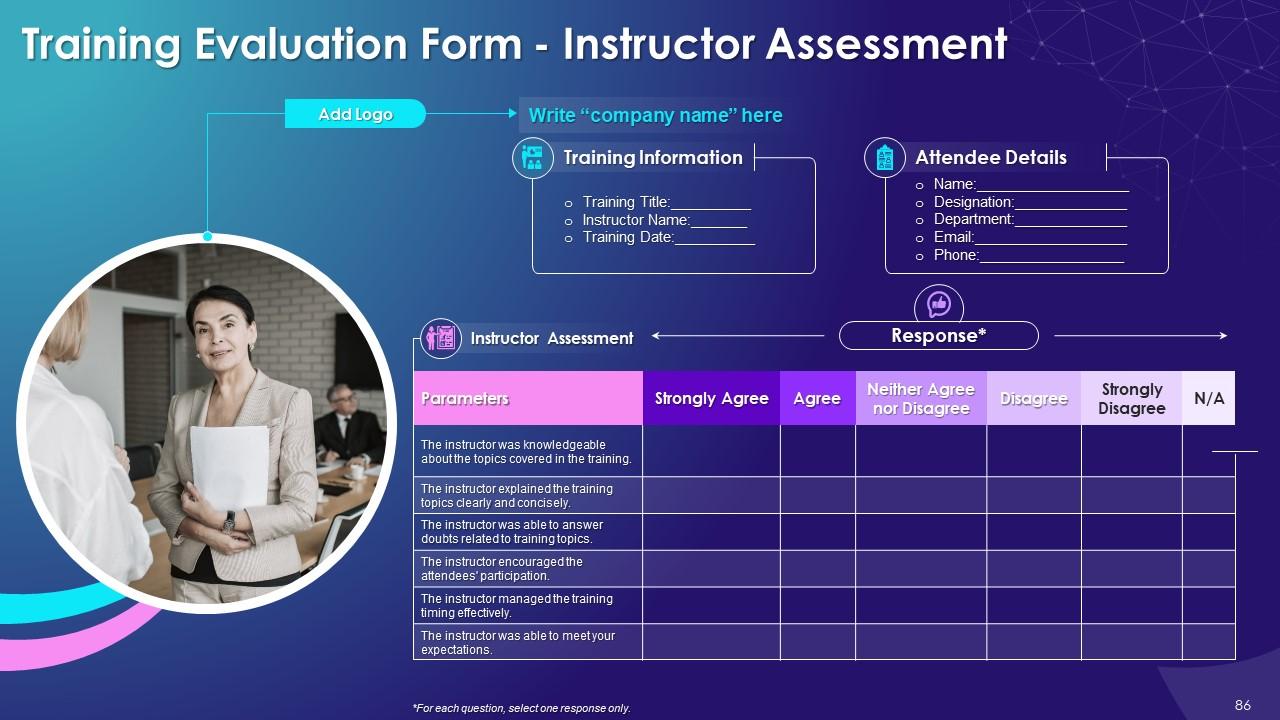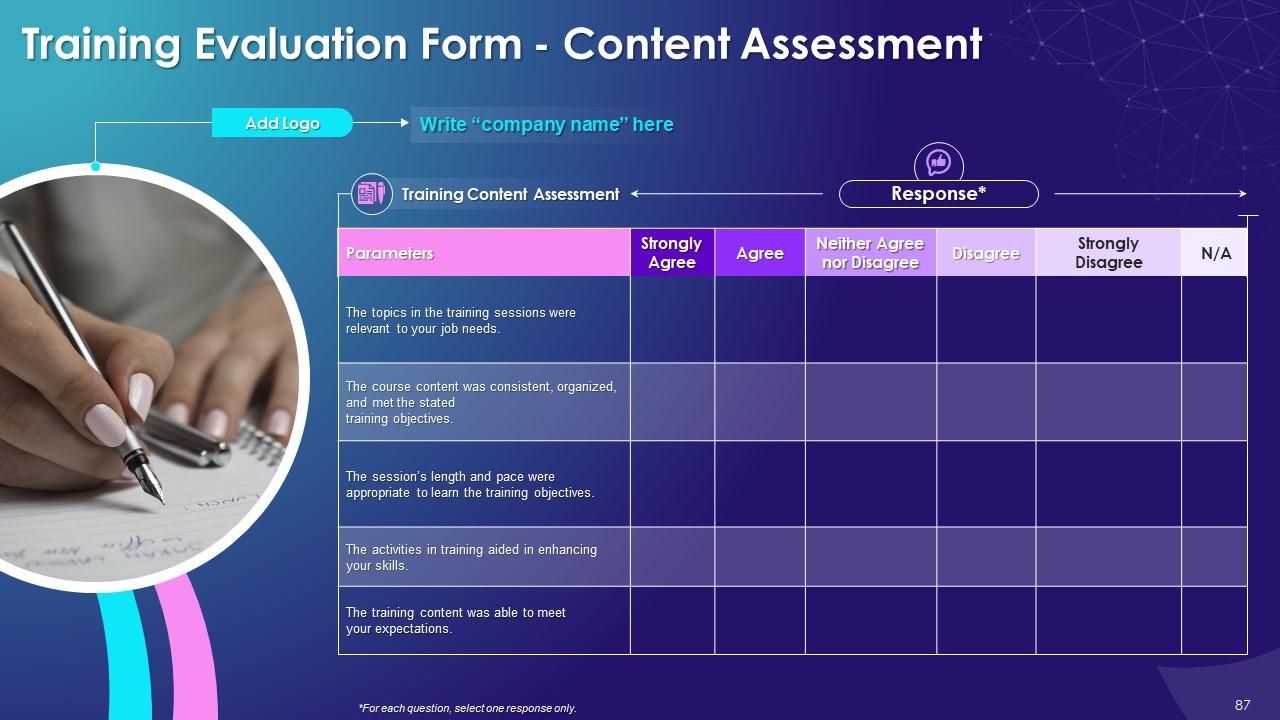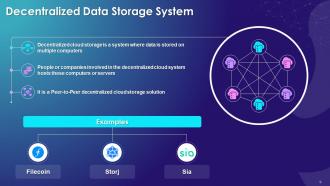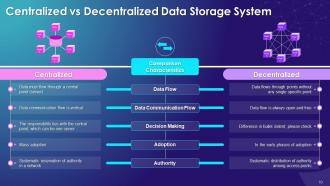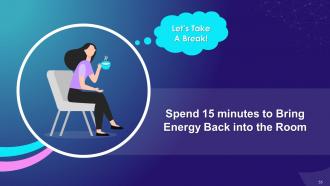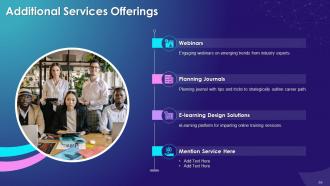Blockchain based Decentralized Data Storage Systems Training Ppt
This PPT training module in-depth explains the concept of blockchain-based decentralized data storage systems. It covers data storage types centralized and decentralized and working blockchain-based decentralized data storage. Further, it covers the benefits of blockchain-based data storage in terms of high reliability, lower costs, increased speed, load balancing, fair market pricing, and increased security and privacy. It also includes PowerPoint slides on the limitations of blockchain-based data storage, such as lack of trust, migration-related concerns, security concerns, and complications in development. It also explains how to rent data storage space online and earn money. The PowerPoint module also has key takeaways, discussion questions, and MCQs related to the topic to make the training session interactive. It also includes additional slides on about us, vision, mission, goal, 30-60-90 days plan, timeline, roadmap, training completion certificate, energizer activities, detailed client proposal, and training assessment form.
This PPT training module in-depth explains the concept of blockchain-based decentralized data storage systems. It covers da..
- Google Slides is a new FREE Presentation software from Google.
- All our content is 100% compatible with Google Slides.
- Just download our designs, and upload them to Google Slides and they will work automatically.
- Amaze your audience with SlideTeam and Google Slides.
-
Want Changes to This PPT Slide? Check out our Presentation Design Services
- WideScreen Aspect ratio is becoming a very popular format. When you download this product, the downloaded ZIP will contain this product in both standard and widescreen format.
-

- Some older products that we have may only be in standard format, but they can easily be converted to widescreen.
- To do this, please open the SlideTeam product in Powerpoint, and go to
- Design ( On the top bar) -> Page Setup -> and select "On-screen Show (16:9)” in the drop down for "Slides Sized for".
- The slide or theme will change to widescreen, and all graphics will adjust automatically. You can similarly convert our content to any other desired screen aspect ratio.
Compatible With Google Slides

Get This In WideScreen
You must be logged in to download this presentation.
PowerPoint presentation slides
Presenting Training Session on Blockchain based Decentralized Data Storage Systems. This presentation deck contains 88 plus well researched and uniquely designed slides. These slides are 100 percent made in PowerPoint and are compatible with all screen types and monitors. They also support Google Slides. Premium Customer Support available. Suitable for use by managers, employees and organizations. These slides are easily customizable. You can edit the color, text, icon and font size to suit your requirements.
People who downloaded this PowerPoint presentation also viewed the following :
Content of this Powerpoint Presentation
Slide 4
This slide highlights the concept of data stored system. It explains that a storage server is used for storing a large amount of data files. It also explains that data storage is confidential and important and there is no compromise on this.
Instructor’s Notes:
The multiple forms of data storage are:
File Storage:
- In this type of storage system, inexpensive and simply constructed data is stored in files and folders
Block Storage:
- Here, data is stored in evenly-sized blocks. It is expensive, complex, and less scalable
- It is suitable for data that must be accessed and edited frequently
Object Storage:
- Object data is ideal for data that does not need to be edited. In this method, data is stored as objects as it is less expensive to store it in this format
Slide 5
This slide highlights types of data storage devices such as SSD storage, hard-disk drives, hybrid storage, cloud storage, and hybrid cloud storage.
Instructor’s Notes:
The multiple types of data storage devices are as follows:
SSD and flash storage:
- It is a solid-state technology that uses flash memory chips for writing and storing data
- SSD uses flash memory to store data
Hard Disk Drives:
- HDD consists of a spinning disk known as platters, and each spinning disk has trillions of tiny fragments that are magnetized to represent bits
- HDDs are used for TV recorders, servers, laptops, etc.
Hybrid storage:
- All-flash arrays can be expensive because of that many organizations adopt a hybrid approach by mixing the speed of flash memory with the storage capacity of hard drives
- With the help of a balanced storage infrastructure, companies can apply the right technology for different storage needs
Cloud storage:
- It is a cost-effective, scalable alternative for storing files
- It allows to save data and files in an off-site location that can be accessed via public internet or a dedicated private network connection
- The provider keeps data secure, manages the data, maintains it, and ensures that the client has access whenever needed
Hybrid cloud storage:
- It combines private and public cloud elements
- Organizations can choose cloud storage and adopt a hybrid cloud storage methodology
- To increase internal storage networks with public cloud storage, some organizations use hybrid clouds
Slide 6
This slide highlights the concept of cloud storage system. It is a method of data storage in which storage is taken online, online in logical pools known as clouds.
Slide 8
This slide illustrates the concept of centralized data storage system. It explains that data is stored at a single location and shared among users with the help of servers.
Slide 9
This slide showcases the concept of decentralized data storage system. It explains that it is a storage system where data is stored on multiple Filecoin, Storj and Sia. It also lists different examples of decentralized data storage system such as filecoin, storj, and sia.
Slide 10
This slide illustrates the comparison between centralized and decentralized system. They are compared on characteristics such as data flow, data communication flow, decision making, adoption, and authority.
Slide 12
This slide showcases the concept of a blockchain-based decentralized data storage system. It explains that a blockchain-based decentralized cloud storage system divides user files into numerous small sets of data in the form of blocks. It also explains that the blockchain-based decentralized data storage system helps users store their files without depending on centralized storage of data.
Slide 13
This slide showcases multiple advantages offered by blockchain technology in data storage systems such as tamper-proof data verifiability, cutting out the intermediaries, and protection against data breaches.
Instructor’s Notes:
The different benefits of blockchain in data storage systems are:
Tamper-Proof Data:
- Creating an effective and verifiable backup helps prove that data has not been tampered with
- Only hashes of data blocks are stored on the distributed cloud storage system
- Encrypted and distributed hashes can easily verify data blocks
Verifiability:
- Blockchain also provides a sequential chain. Each block contains a cryptographic hash of the previous block
- It links blocks, thereby creating a decentralized transaction ledger
No More Middlemen:
- The major change that blockchains are likely to bring is disintermediation
- Distribution across a chain of computers also makes blockchain harder to attack
- It is a self-verified sequential storage scheme that can be used to immutably record transactions and ownership for negotiating and enforcing contracts
Data Breaches:
Blockchain technology helps in reducing cases of data breaches
Slide 15
This slide provide information about the blockchain technology advantage of tamper proof data for effective data storage.
Slide 16
This slide includes details of on how blockchain technology provides an edge in verifying data, and is effective in data storage as well.
Slide 17
This slide provides information about the disintermediation benefit of blockchain technology for effective data storage.
Slide 18
This slide highlights the advantage of blockchain technology in preventing data breaches in storage systems.
Slide 19
This slide showcases different platforms for decentralized data storage that organisations such as Arweave; BitTorrent; Filecoin; Sia and Utopia are providing
Instructor’s Notes:
Different organizations providing platform for public decentralized data storage are:
Arweave:
- It is a blockchain-like peer-to-peer storage protocol that provides extra storage capacities available on personal computers, acting as Arweave clients
- The application enabling data storage and functionality is called Permaweb
- It is an immutable environment for storing web-pages and other kind of data such as static files
BitTorrent:
- The BitTorrent is the oldest and most well-known decentralized data storage network
- It has evolved into an entire suite of products, including the BitTorrent File System (BTFS)
- BTFS is a scalable decentralized storage system; it is designed to reduce storage costs, improve fault tolerance and avoid government censorship
Filecoin:
- It is an open-source system for public cryptocurrency and a digital payment system based on blockchain technology
- The main functionality it offers is that it allows users to rent unused hard drive space
Sia:
- It uses a blockchain system for providing a decentralized data storage platform that encrypts and distributes files across a global P2P network
- Sia is open-source and includes an Application Programming Interface (API) that developers use while building applications
Utopia:
- It is designed to act as a tool for reclaiming online freedom and anonymity
- It provides a secure communication system that prevents any government and third-party surveillance
- It supports two different cryptocurrencies: Crypton and Utopia USD
Slide 22
This slide different limitations of blockchain based decentralized data storage such as lack of trust, migration-related concerns, complications in development, security concerns, and the technology needs time to go mainstream.
Instructor’s Notes:
The multiple disadvantages of blockchain based decentralized data storage are:
Lack of Trust:
- It works on Peer-to-Peer technology. Businesses and customers find it difficult to trust the decentralized network as it lacks accountability for lost data or misplaced transactions
- Developers, however, are working to create a high level of security within the decentralized network
Migration-Related Concerns:
- This technology is in its initial stages of development; this phase will continue for a few more years
- Performance issues keep businesses and consumers from immediately migrating to decentralized storage systems
- For early adopters, it is the right time to jump-in on this technology before it becomes as mainstream as the cloud
- Developers are trying to tackle all performance-related challenges
Complications in development:
- It is tricky to execute a consensus mechanism from the perspective of developing a blockchain-based decentralized storage network
- The consensus mechanism is fundamental for the proof of storage; it helps verify the integrity of remote files
Security Concerns:
- The decentralized storage network is secure but remains a target for hackers
- Hackers can form malicious nodes and execute hub-attacks that distort and endanger the whole network
Needs time to go mainstream:
- The decentralized storage system offers a solution to all concerns associated with centralized storage
- Implementing the decentralized system widely requires delivering a service superior current market offering
- The technology is in the initial phase of development and will take time to become popular
Slide 23
This slide showcases the process by which individuals can earn money by renting out data storage space online. It also explains how storj can be used for renting out data storage spaces.
Slide 24
This slide showcases use cases of blockchain data management such as legal document management, accounting, intellectual property, government, and security.
Instructor’s Notes:
The use cases of blockchain data management are:
Legal Document Management:
- The use of blockchain to authenticate legal documents is a consequence of its immutable and tamper-resistant storage
- Currently, the data and veracity of legal documents are established with a mutual agreement or a third party. Typically, these are a notary, the
e- signature mechanism, or email - These methods are not completely reliable but storing records on a public blockchain provides valid proof that documents do exist and are available, when needed
Accounting:
- Frauds in accounting will remain a problem in the system as human beings are involved in the preparation of accounts
- The use of blockchain technology, however, helps reduce fraud and improve the efficiency of the accounting process
Intellectual Property:
- Digitization in modern art and intellectual property has increased the problem of duplicacy due to the possibility of creating duplicate artwork
- The ownership and apparent date of creation can be easily modified
- The system of Private Key Infrastructure (PKI) does allow the signing of digital creation, but it does not include a reliable timestamp. Thus, it becomes impossible to determine which of the signed digital assets were created first
- Combining PKI with blockchain technology, users, users can provide a complete digital intellectual property rights solution
- Placing the signed asset on a blockchain helps identify the actual digital asset
Governance:
- The government is the main arbiter of our legal and intellectual property systems, and it regulates most aspects of financial accounting
- By using blockchain for legal and intellectual property matters, the government is in a position to offer better governance; it can also offer additional, unique incentives to stakeholders
- As society becomes more digitize government will also need to move from paperwork to digital record keeping. Blockchain technology offers effective ways to maintain and secure records
Security:
- Blockchain has emerged as a key technology for defending our digital security key technology for defenders of digital security
- The immutability of blockchain records creates many opportunities in both preventing and limiting the chance of breach and reacting and responding, if and when it breaches occurs in any digital system
Slide 26
This slide showcases the key takeaways of blockchain technology in data storage system.
Slide 43 to 57
These slides depict energizer activities to engage the audience of the training session.
Slide 59 to 85
These slides consist of a client training proposal highlighting what the company providing corporate training can accomplish for the client.
Slide 86 to 88
These slides highlight the training evaluation form for instructor, content, and course assessment.
Blockchain based Decentralized Data Storage Systems Training Ppt with all 93 slides:
Use our Blockchain based Decentralized Data Storage Systems Training Ppt to effectively help you save your valuable time. They are readymade to fit into any presentation structure.
-
Impressive templates. Designing a presentation is fun now!
-
Great product, helpful indeed!


